Bird Feeding and Girl Gagging Videos
Bird Feeding
- Sunflower seeds are among the most versatile food for birds.
- Where you live, the type of food you offer, and the habits of different bird species will determine the types of birds you will attract to your feeder.
- There are ways to prevent squirrels, cats, and dogs from harming birds or their food at feeders.
- It is best not to feed ducks and geese.
Types of feeders
The best way for most Canadians to start a study of birds is to establish a bird feeder, and the best time to feed birds is in the winter, when there are fewer species present and when many birds can be attracted to the bird feeder for observation. Watching the feeding birds can help people recognize the different species and learn about the birds' habits of migration, nesting, and feeding.
Feeding birds can be a very simple affair. Just scattering bread crusts on the snow or seed on a bench or table will attract some birds. But if bird feeding is to be a long-term interest, some additional steps should be taken to avoid problems.
- The food must be protected from rain and snow or from unwanted guests such as squirrels.
- It is best to place food in a feeder which protects seed from bird droppings.
- The birds should not be made vulnerable to predation or other hazards by careless placement of the bird feeder.
- It is important to continue feeding through bad weather so that any birds that may have become dependent on the food supply will be able to eat when they need to. This is most important just after winter storms. (Of course, if your neighbours are also putting out bird food, the birds are less dependent on any one feeder).
A hopper-type feeder that can hold food for several days can help ensure a continuous supply. Many good feeders can be made at home. A plastic bleach bottle can be cut to provide a large opening in one side and then hung from a branch by its handle. Half a coconut, pine cones, or a piece of bark can be used to hold a suet mixture. Suet can be hung from a tree in a plastic mesh onion bag. A Christmas string of popcorn and cranberries draped on a tree is a festive offering for the birds. Just be sure that feeders have no exposed metal parts in areas where the weather gets very cold. Commercially built feeders can also be an excellent value.
What to feed
Try a few foods and use what works. Sunflower seeds are among the most versatile food for birds. Two kinds of sunflower seeds are used, a larger striped kind and a smaller black kind; the black kind is popular with more species of birds. Sunflower seeds may be used without any other food, if desired.
Commercial bird seed mixtures sometimes contain seeds that are of little interest to most birds. Millet is good, but a study by the United States Fish and Wildlife Service showed that, in one region at least, white proso millet was generally preferred to yellow or red millet. Many species like cracked corn, but the corn is likely to spoil if wet, and it is more attractive to species, like pigeons, that are often considered pests. Oats, buckwheat, wheat, and rapeseed have limited interest for birds. Niger seed (an imported thistle seed) is excellent for small finches but can be expensive.
Many types of kitchen scraps can be given to birds. Of these, some of the most often used are baked goods (give sparingly and watch for mould) and fats. Larger pieces of fat, especially beef suet, can be used as is or can be rendered by heating to separate the fat from the connective tissue. Melted fat can be mixed with bread crumbs and seeds and packed into dishes or other feeders. Peanut butter is loved by birds, but some people say it should be mixed with fat to reduce any danger of choking.
Most birds appreciate water to drink if the weather is not too cold. Birds also use grit to help their digestion. Provide dirt, sand, or ground eggshells separately from other foods for this purpose. Sometimes a few wood ashes or a dry supply of salt can provide minerals the birds need.
To limit cost, put a measured amount of food out each day, whatever you decide you can afford. If the feeder is empty an hour later, don't worry. If you are consistent, the birds will adjust their foraging to the supply and find more food elsewhere.
The Birds
What kind of birds can you expect once you've put out some food? The bird species attracted to a feeder will depend on many factors, including the geographic region you live in, the type of food you offer, the habitat of the immediate area, the habits of individual bird species, and the weather. Habitat is a very important factor in attracting birds: an area with trees and shrubs will be the most likely to appeal to them. It is also important to start feeding early in the fall before the birds become set in their winter foraging patterns.
Table 1 lists many of the species that come to feeders in Canada. These species, most of which are discussed below, are widespread and can be found in most regions where there are mature trees, even in densely populated urban areas. Table 1 also indicates some of the birds' favourite foods. Do not assume, however, that birds in your area will necessarily exhibit the preferences shown. Experiment, and you may find other useful foods not listed in the table.
Chickadees are some of the most familiar birds that visit feeders. They travel around a small area of a few hectares, stopping in woodlots where they look for insects and insect eggs and coming to feeders for sunflower seeds and suet. They are adept at opening sunflower seeds by holding them with their feet and striking them with their bills, like little woodpeckers.
Blue Jays are conspicuous visitors with their bright plumage. In the fall, Blue Jays store food, sometimes carrying away many sunflower seeds packed in their cheeks. At that time of year you might like to feed the Blue Jay some whole corn, which is less expensive than sunflower seeds. Blue Jays are much less trusting of people than chickadees are and usually retreat to a distant viewing point when people come to the feeder.
Several species have changed their winter range, thanks to bird feeding. Among these are Evening Grosbeaks, which come in flocks for sunflower seeds. Cardinals have started nesting far north of their historical range, probably because of the winter food provided at feeders.
Some birds are quite unpredictable in their annual visits to bird feeders. Redpolls, Evening Grosbeaks, and Pine Siskins come in variable numbers depending on their natural food supply and on the weather. Others, such as the Hairy Woodpecker and the Black-capped Chickadee, are resident year-round in the feeding area and so can be expected at feeders with some certainty.
The House Finch is of special interest at feeders. It was originally a western species, but in 1941 a few individuals were released in New York City. Since then it has spread and has become common in southern parts of Ontario and Quebec. More recently it declined again, as a result of a disease that may have been spread, in part, through concentration of the species at bird feeders.
Some birds that usually eat dormant insects and their eggs in the winter can be attracted to feeders by fat-rich foods such as suet, and, for some species, sunflower seeds. Nuthatches, woodpeckers, and chickadees are all fat-loving species. Some people do not like pigeons, starlings, or House Sparrows and prefer jays, chickadees, and finches. Offering sunflower seeds alone may help eliminate the first group and attract the second. Fat attracts starlings but is probably worth it if it brings woodpeckers too.
A yard with plantings of bushes such as saskatoon, elderberry, mountain ash, nannyberry, and crabapple or vines such as wild grape or Virginia creepers will attract birds that eat fruit and are rarely found at regular feeders. Even the American Robin will overwinter where such a food supply is abundant.
Problems
Sometimes problems develop at bird feeders. Perhaps the most common is the presence of squirrels, which can eat a large amount of food and can also damage wooden feeders. It is possible to buy a squirrel-proof bird feeder. You can also make one at home by placing inverted metal funnels on the feeder post below the feeder or by positioning large disks above hanging feeders. Remember that squirrels can jump, especially from above, that they can walk on a tight rope, and that they can get toeholds on any imperfections in whatever you are using to exclude them.
Cats and sometimes dogs can be a worse problem; they may kill the birds or take suet at feeders. If these animals have free range around the feeder, avoid giving them places to hide from which they can pounce on birds. Be sure the feeders are close to natural hiding places for the birds, such as shrubs, but far enough away from them—2 to 3 m—to keep birds safe from cats that may be using the shrubs as cover. Other predators may also visit feeders, but these wild animals have a role in nature, and we should respect their need for food.
Sometimes birds fly into windows and injure themselves. This usually happens when feeders are placed less than 10 m from windows, because at this distance, birds can see vegetation reflected in the windows or through the windows. If a window near a feeder has a number of such bird strikes, try leaving a curtain closed when the birds are feeding. If this does not help, you may have to move the feeder. A bird feeder can usually be safely fastened to a window or placed very close to it, because in this case, if birds are startled while at the feeder, they will be moving too slowly to injure themselves if they hit the window.
Most other problems can be avoided by regular attention to the feeder. Keep the feeder well stocked in bad weather, and do not let wet food stay in the feeder long enough to spoil. Notice which foods are being ignored by the birds, and adapt your feeding plan accordingly.
Many people like to feed waterfowl, including ducks and geese. In fact, it is best not to do so. Water birds that come to rely on handouts may lose their compulsion to migrate and their fear of people, and they may pick up habits that might harm both the birds and people. When birds are not afraid of cars and planes, for example, they may cause safety problems by walking across roads or flying across airport runways. And the birds' tendency to gather in large groups in confined areas when they expect to be fed increases competition for limited food supplies. When winter arrives, the added stresses of eating less nutritious food than they would consume under normal conditions and exposure to harsh weather make the birds more susceptible to life-threatening diseases. If you just can't help yourself, don't feed the birds before the end of the hunting season in your area. It is illegal to put out food for waterfowl during the hunting season except under permit. Your best food choices are grains like wheat and corn because they keep well outside.
Other activities
A well-established feeder provides a starting point for other activities with birds. Photography of birds at the feeder can provide hours of enjoyment. If you are taking pictures of birds, watch to see how they use branches as stopping places before they fly to the feeder. Set up your camera to focus on one of the branches for more natural pictures than are possible on the feeder itself. Feeding can be continued through the summer months to attract a different mix of species. You will sometimes be rewarded by local nesting species bringing their young to the feeder. It is interesting to keep records of the birds at your feeder. In Canada, the Long Point Bird Observatory in Port Rowan, Ontario, coordinates Project FeederWatch. In that survey, observers have recorded over 100 different kinds of birds at feeders, and many mammals as well.
Resources
Online resources
Audubon and Cornell Laboratory of Ornithology
Project FeederWatch
Print resources
Dobson, C. 1981. Feeding wild birds in winter. Firefly Books. Scarborough, Ontario.
Dunn, E. H., and D. L. Tessaglia-Hymes. 1999. Birds at your feeder. Norton, New York.
Geis, A. D. 1980. Relative attractiveness of different foods at wild bird feeders. Wildlife No. 233. Special Scientific Report. U.S. Fish and Wildlife Service, Washington, D.C.
Kress, S. W. 1986. The Audubon Society Guide to attracting birds. National Audubon Society, New York.
McElroy, T. P. 1985. The new handbook of attracting birds. Second edition. Norton, New York.
Robbins, C. S., B. Bruun, and H. S. Zim. 1983. Birds of North America: A guide to field identification. Revised edition. Golden Press, New York.
Terres, J. K. 1977. Song birds in your garden. Hawthorn Books, New York.
© Her Majesty the Queen in Right of Canada, represented by the Minister of the Environment, 1987, 1993, 2003, 2005. All rights reserved.
Catalogue number CW69-4/21-2003E-IN
ISBN 0-662-34269-0
Text: Steve Wendt
Revision: Steve Wendt, 1993; Steve Wendt, Erica Dunn, and Becky Whittam, 2003
Editing: Maureen Kavanagh, 2003, 2005
Photos: Gerry Beyersbergen
-
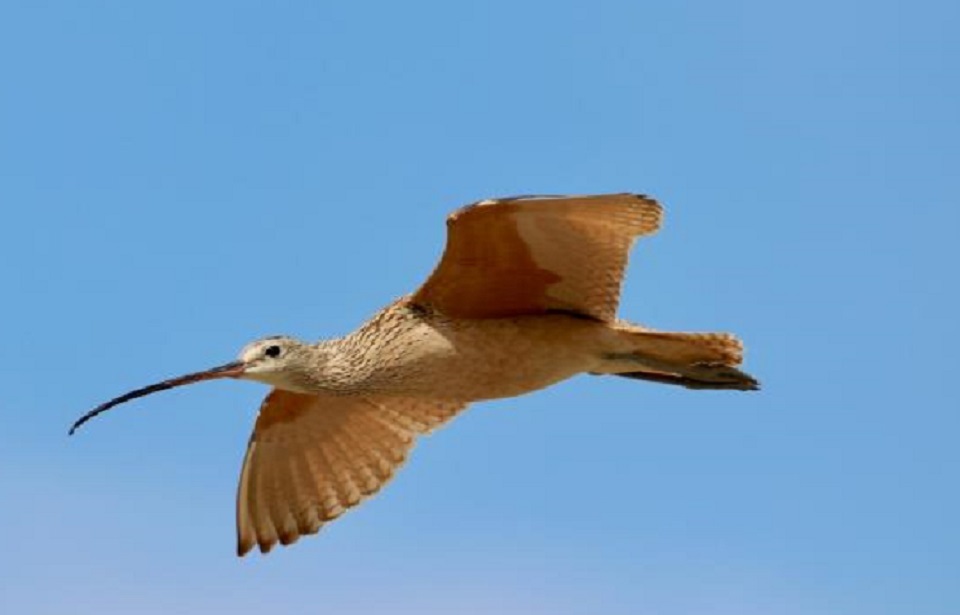 Ken Risi Long-billed Curlew Long-billed Curlew (Youth) Long-billed Curlew (15 seconds) Long-billed Curlew (30 secondes) Long-billed Curlew
Ken Risi Long-billed Curlew Long-billed Curlew (Youth) Long-billed Curlew (15 seconds) Long-billed Curlew (30 secondes) Long-billed Curlew -
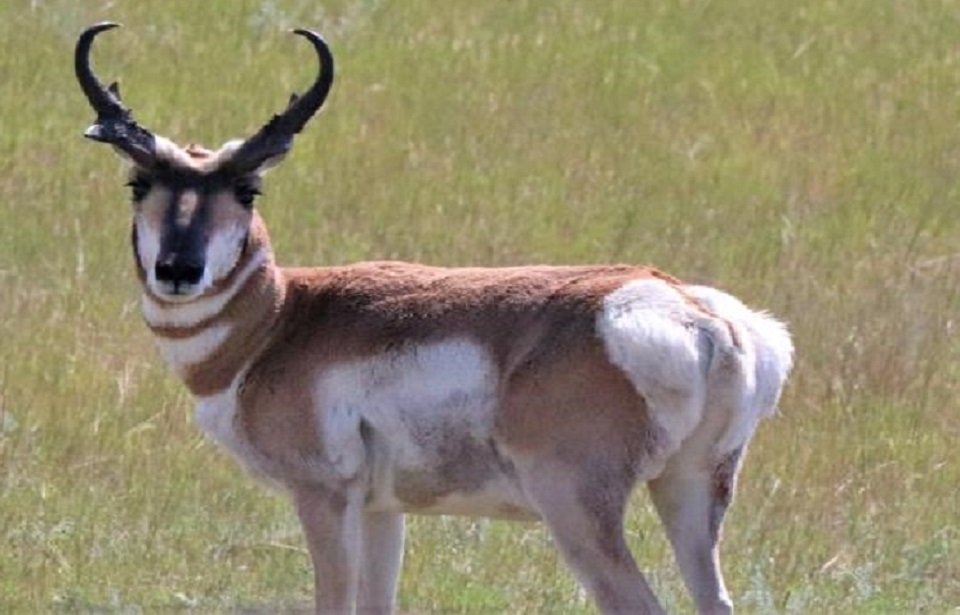 Amber Fortowsky Pronghorn Pronghorn (Youth) Pronghorn (15 seconds) Pronghorn (30 seconds) Pronghorn
Amber Fortowsky Pronghorn Pronghorn (Youth) Pronghorn (15 seconds) Pronghorn (30 seconds) Pronghorn -
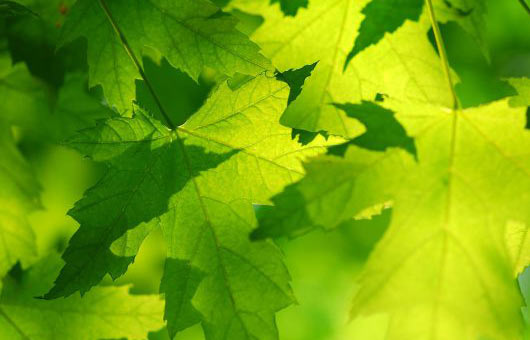 Sugar Maple Sugar Maple (15 seconds) Sugar Maple (30 seconds) Sugar Maple (long version) Sugar Maple (Youth)
Sugar Maple Sugar Maple (15 seconds) Sugar Maple (30 seconds) Sugar Maple (long version) Sugar Maple (Youth) -
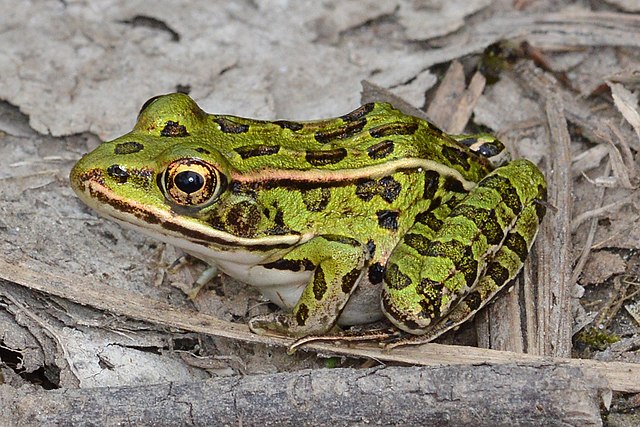 Ryan Hodnett Northern Leopard Frog Wetland Wonderland (webisode) Wetlands (30 seconds) Wetlands (60 seconds)
Ryan Hodnett Northern Leopard Frog Wetland Wonderland (webisode) Wetlands (30 seconds) Wetlands (60 seconds) 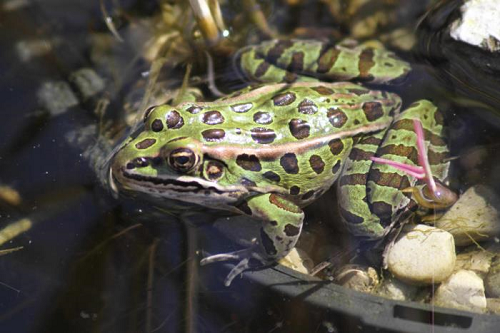
Northern Leopard Frog The Northern Leopard Frog (Lithobates pipiens) is named for its leopard-like spots across its back and sides. Another common name for this frog is the 'meadow frog' for its common habitat. Historically, these frogs were harvested for food (frog legs) and are still used today for dissection practice in biology class.
Northern Leopard Frogs are about the size of a plum, ranging from 7 to 12 centimetres. They have a variety of unique colour morphs, or genetic colour variations. They can be different shades of green and brown with rounded black spots across its back and legs and can even appear with no spots at all (known as a burnsi morph). They have white bellies and two light coloured dorsal (back) ridges. Another pale line travels underneath the nostril, eye and tympanum, ending at the shoulder. The tympanum is an external hearing structure just behind and below the eye that looks like a small disk. Black pupils and golden irises make up their eyes. They are often confused with Pickerel Frogs (Lithobates palustris); whose spots are more squared then rounded and have a yellowish underbelly.
Male frogs are typically smaller than the females. Their average life span is two to four years in the wild, but up to nine years in captivity. Tadpoles are dark brown with tan tails.
-
 Cowichan Lake Lamprey Cowichan Lake Lamprey (Home Grown)
Cowichan Lake Lamprey Cowichan Lake Lamprey (Home Grown) 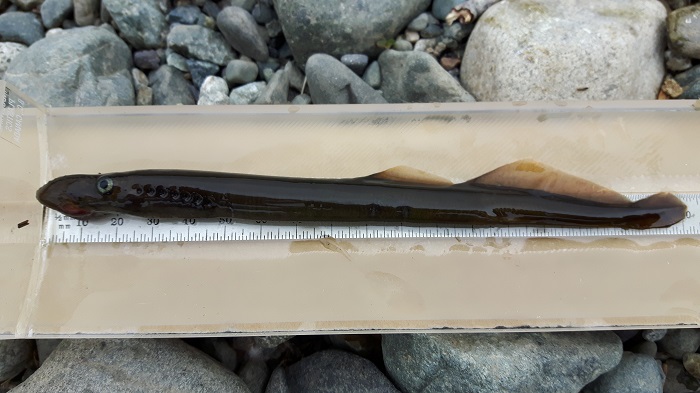
Cowichan Lake Lamprey Lampreys are an amazing group of ancient fish species which first appeared around 360 million years ago. This means they evolved millions of years before the dinosaurs roamed the earth. There are about 39 species of lamprey currently described plus some additional landlocked populations and varieties.
In general, lamprey are one of three different life history types and are a combination of non-parasitic and parasitic species. Non-parasitic lamprey feed on organic material and detritus in the water column. Parasitic lamprey attach to other fish species to feed on their blood and tissues. This is why lamprey are often unfairly called "aquatic vampires".
Most, 22 of the 39 species, are non-parasitic and spend their entire lives in freshwater. The remainder are either parasitic spending their whole life in freshwater or, parasitic and anadromous. Anadromous parasitic lampreys grow in freshwater before migrating to the sea where they feed parasitically and then migrate back to freshwater to spawn.
The Cowichan Lake lamprey (Entosphenus macrostomus) is a freshwater parasitic lamprey species. It has a worm or eel-like shape with two distinct dorsal fins and a small tail. It is a slender fish reaching a maximum length of about 273mm. When they are getting ready to spawn they shrink in length and their dorsal fins overlap.
Unlike many other fish species, when lampreys are getting ready to spawn you can tell the difference between males and females. Females develop fleshy folds on either side of their cloaca and an upturned tail. The males have a downturned tail and no fleshy folds. Lamprey don't have gills like other fish species but have pores for breathing. These seven gill pores are located one after another behind the eye.
There are several characteristics which are normally used to identify lamprey. Many of these are based on morphometrics or measurements, of or between various body parts like width of the eye or, distance between the eye and the snout. Other identifying characteristics include body colour and the number and type of teeth.
Some distinguishing characteristics of this species are the large mouth, called and oral disc and a large eye. This species also has unique dentition. For example, these teeth are called inner laterals. Each lateral tooth has cusps and together they always occur in a 2-3-3-2 cusp pattern.
-
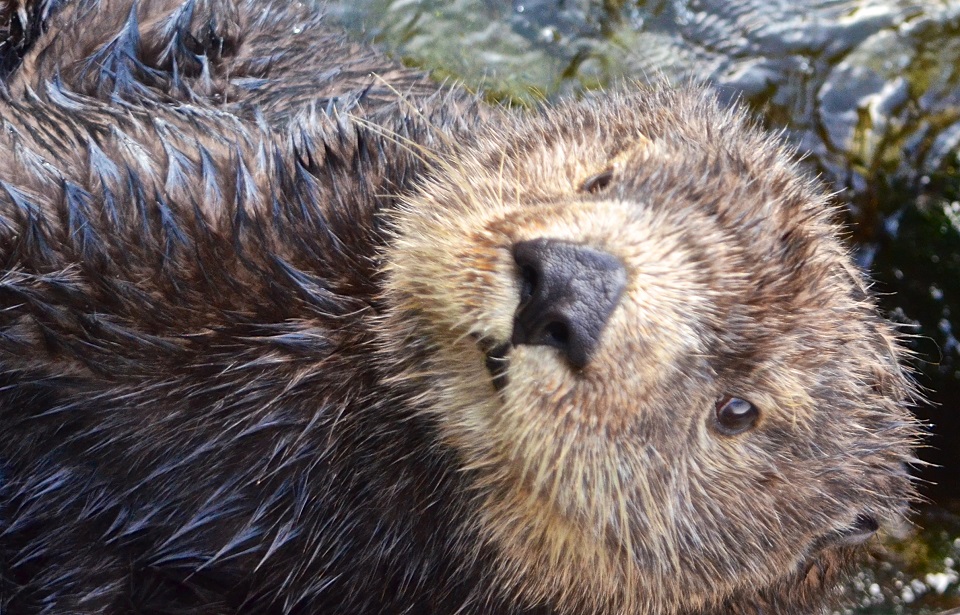 Annie Langlois Sea Otter Sea Otter Sea Otter (Youth) Sea Otter (30 seconds) Sea Otter (15 seconds) Ocean Commotion (webisode)
Annie Langlois Sea Otter Sea Otter Sea Otter (Youth) Sea Otter (30 seconds) Sea Otter (15 seconds) Ocean Commotion (webisode) 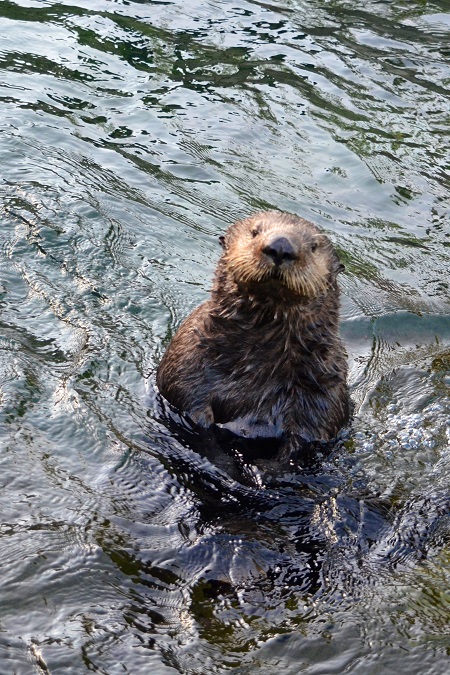
Sea Otter The Sea Otter (Enhydra lutris) is the smallest marine mammal in North America – males measure 1.2 metres in length and weigh an average of 45 kilograms (females are a bit smaller). At the same time, the Sea Otter is the largest member of its family, the mustelids, which includes River Otters, weasels, badgers, wolverines and martens. It's also the only member of its family that doesn't need land at all; it's completely adapted to life in the water. It may come to land to flee from predators if needed, but the rest of its time is spent in the ocean.
The Sea Otter's fur is one of the thickest in the animal kingdom, with 150,000 or more hairs per square centimetre. It varies in colour from rust to black. Unlike seals and sea lions, the Sea Otter has little body fat to help it survive in the cold ocean water. Instead, it has both guard hairs and a warm undercoat that trap bubbles of air to help insulate it. The otter is often seen at the surface grooming; in fact, it is pushing air to the roots of its fur.
-
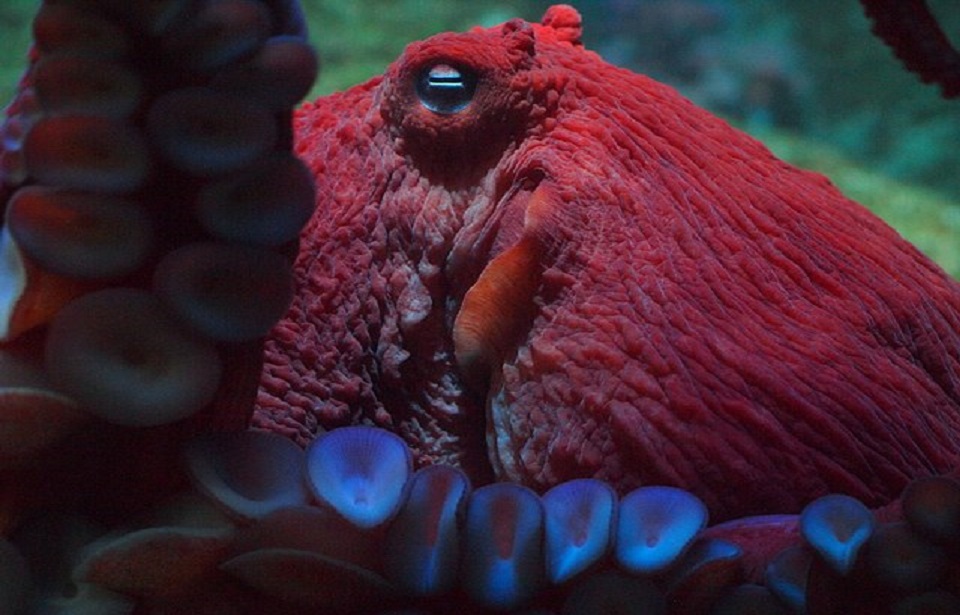 Bill Abbott Northern Giant Pacific Octopus Northern Giant Pacific Octopus Northern Giant Pacific Octopus (30 seconds) Northern Giant Pacific Octopus (Youth) Northern Giant Pacific Octopus (15 seconds) Ocean Commotion (webisode)
Bill Abbott Northern Giant Pacific Octopus Northern Giant Pacific Octopus Northern Giant Pacific Octopus (30 seconds) Northern Giant Pacific Octopus (Youth) Northern Giant Pacific Octopus (15 seconds) Ocean Commotion (webisode) 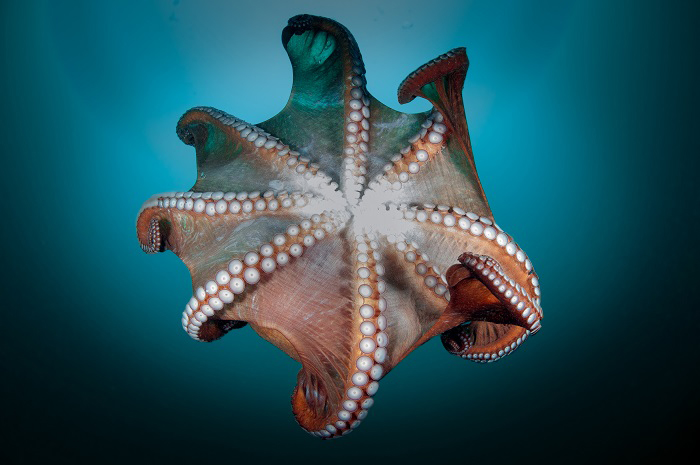
Giant Pacific Octopus Underside The Northern Giant Pacific Octopus (Enteroctopus dofleini) is a large cephalopod mollusk, which means it's related to gastropods (snails and slugs) and bivalves (clams and oysters). Mollusks are invertebrates, meaning they have no bones. Insects are also invertebrates, but mollusks differ from insects in that they don't have an exoskeleton. They are cold-blooded, like all invertebrates, and have blue, copper-based blood. The octopus is soft-bodied, but it has a very small shell made of two plates in its head and a powerful, parrot-like beak.

Anatomy of the Giant Pacific Octopus' head The Giant Pacific Octopus is the largest species of octopus in the world. Specimens have weighed as much as 272 kg and measured 9.6 m in radius (although they can stretch quite a bit), but most reach an average weight of only 60 kg. They're normally reddish-brown in colour.
-
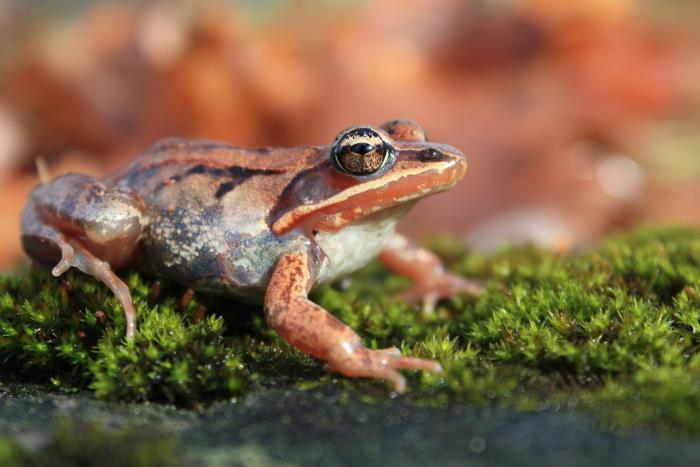 Susan Enders Chorus Frogs Chorus Frogs Chorus Frogs (Youth) Chorus Frogs (15 seconds) Chorus Frogs (30 seconds) Wetland Wonderland (webisode)
Susan Enders Chorus Frogs Chorus Frogs Chorus Frogs (Youth) Chorus Frogs (15 seconds) Chorus Frogs (30 seconds) Wetland Wonderland (webisode) There are two species of chorus frogs here in Canada: the Boreal Chorus Frog (Pseudacris maculata) and the Western Chorus Frog (Pseudacris triseriata). Prior to 1989, all Canadian chorus frogs were considered to be one species, as they are very similar – it's even hard for scientists to differentiate them! Studies determined, though, that they are indeed different. While the Western Chorus Frog might have slightly shorter legs than the Boreal Chorus Frog, and that their respective calls have different structures, genetics have proven this.

Boreal Chorus Frog (left), Western Chorus Frog (right) Chorus Frogs are about the size of large grape, about 2.5cm long on average, with a maximum of 4cm. They are pear-shaped, with a large body compared to their pointed snout. Their smooth (although a bit granular) skin varies in colour from green-grey to brownish. They are two of our smallest frogs, but best ways to tell them apart from other frogs is by the three dark stripes down their backs, which can be broken into blotches, by their white upper lip, and by the dark line that runs through each eye. Their belly is generally yellow-white to light green.
Males are slightly smaller than females, but the surest way to tell sexes apart is by the fact that only males call and can inflate their yellow vocal sacs. Adults tend to live only for one year, but some have lived as many as three years.
Their tadpoles (the life stage between the egg and the adult) are grey or brown. Their body is round with a clear tail.
-
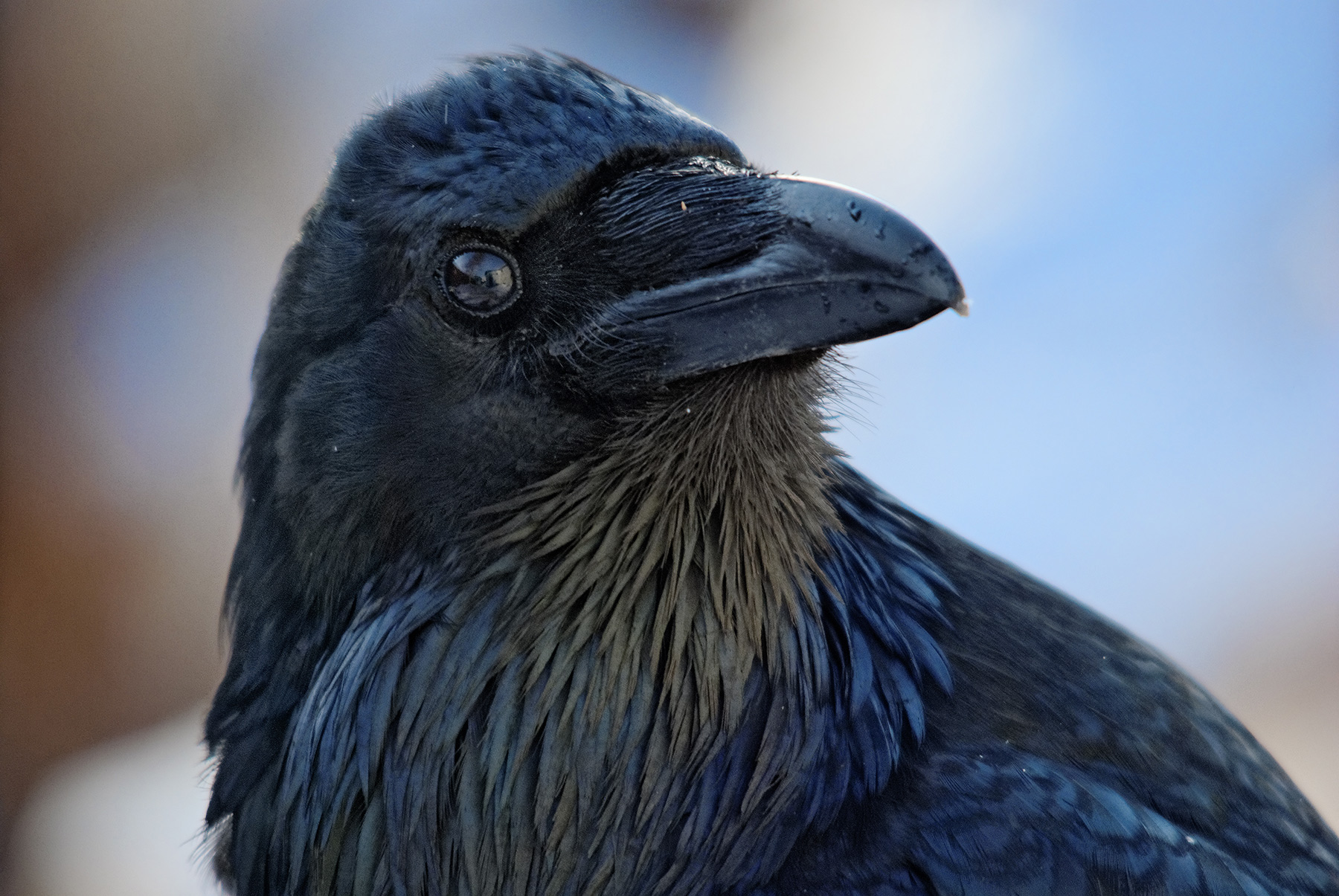 Keith Williams Common Raven Common Raven (15 seconds) Common Raven (Youth) Common Raven Common Raven (30 seconds)
Keith Williams Common Raven Common Raven (15 seconds) Common Raven (Youth) Common Raven Common Raven (30 seconds) 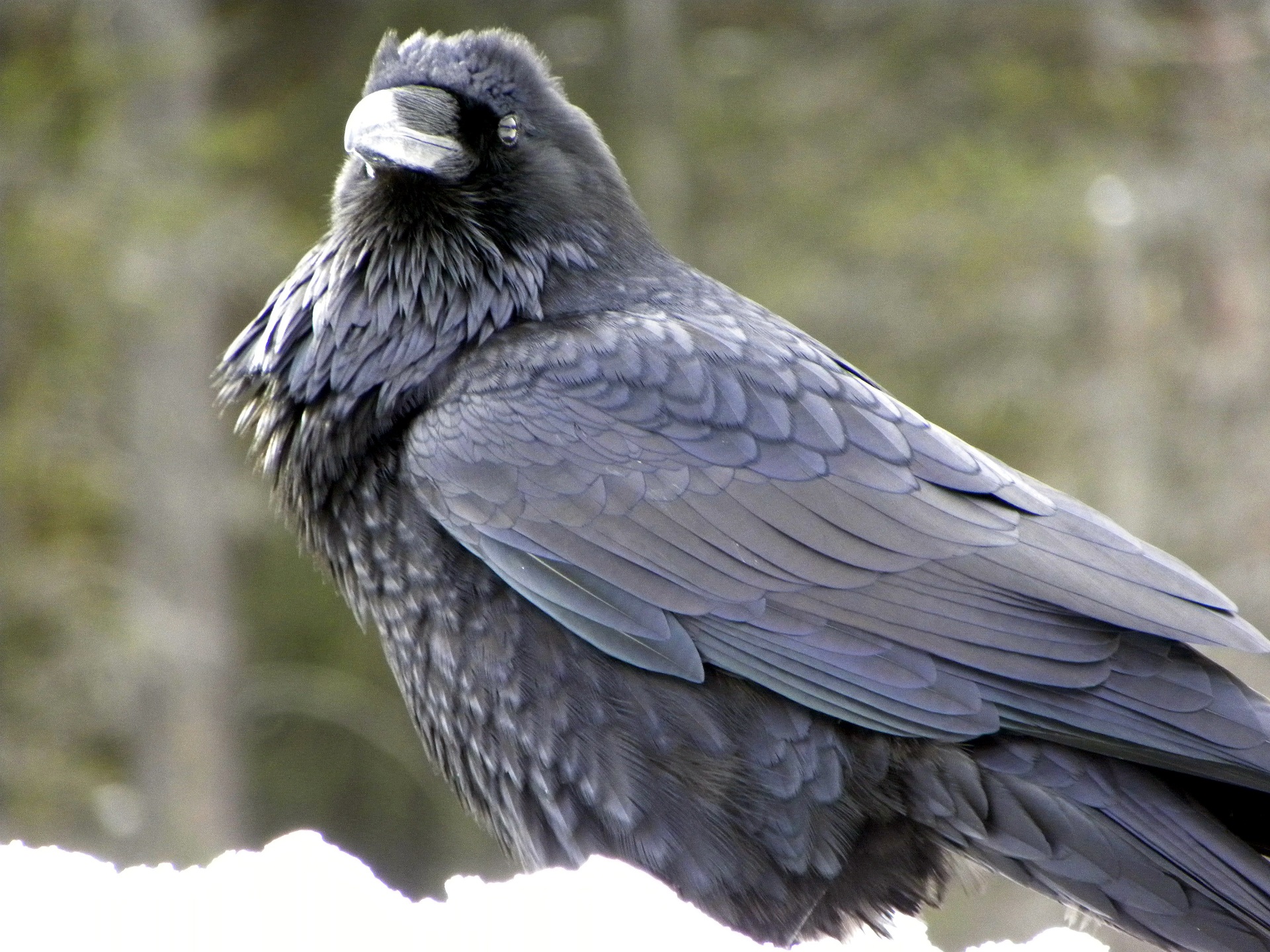
Common Raven showing its hackles and large beak The Common Raven Corvus corax is one of the heaviest passerine birds and the largest of all the songbirds. It is easily recognizable because of its size (between 54 and 67 centimetres long, with a wingspan of 115 to 150 cm, and weighing between 0.69 and two kilograms) and its black plumage with purple or violet lustre. It has a ruff of feathers on the throat, which are called 'hackles', and a wide, robust bill. When in flight, it has a wedge-shaped tail, with longer feathers in the middle. While females may be a bit smaller, both sexes are very similar. The size of an adult raven may also vary according to its habitat, as subspecies from colder areas are often larger.
A raven may live up to 21 years in the wild, making it one of the species with the longest lifespan in all passerine birds.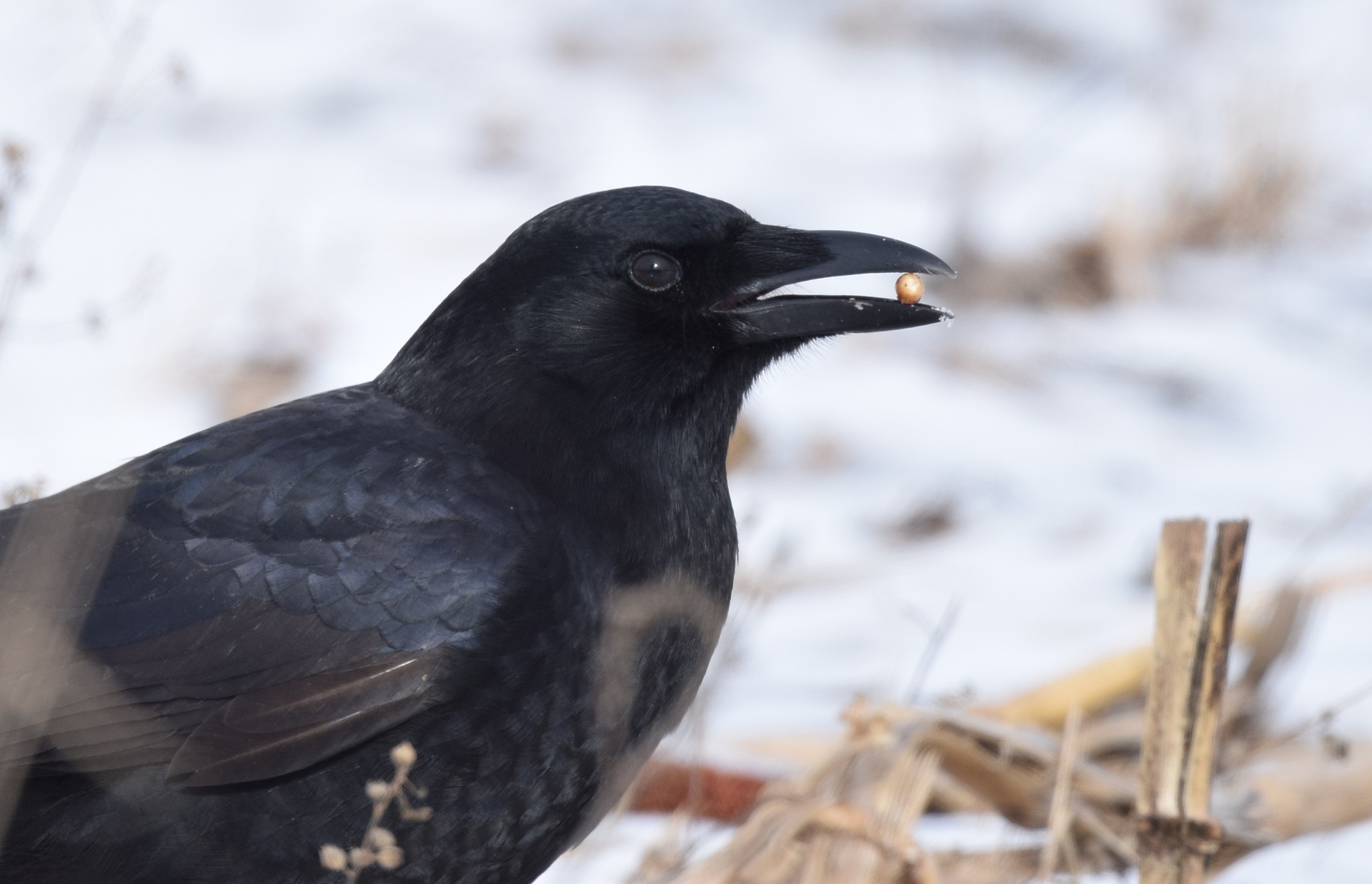
American Crow
The Common Raven is often mistaken for an American Crow in southern Canada and the United States. Both birds are from the same genus (order of passerine birds, corvid family –like jays, magpies and nutcrackers, Corvus genus) and have a similar colouring. But the American Crow is smaller (with a wingspan of about 75 cm) and has a fan-shaped tail when in flight (with no longer feathers). It also has a narrower bill and lacks the raven's hackles. Their cries are different: the raven produces a low croaking sound, while the crow has a higher pitched cawing cry. While adult ravens tend to live alone or in pairs, crows are more often observed in larger groups.
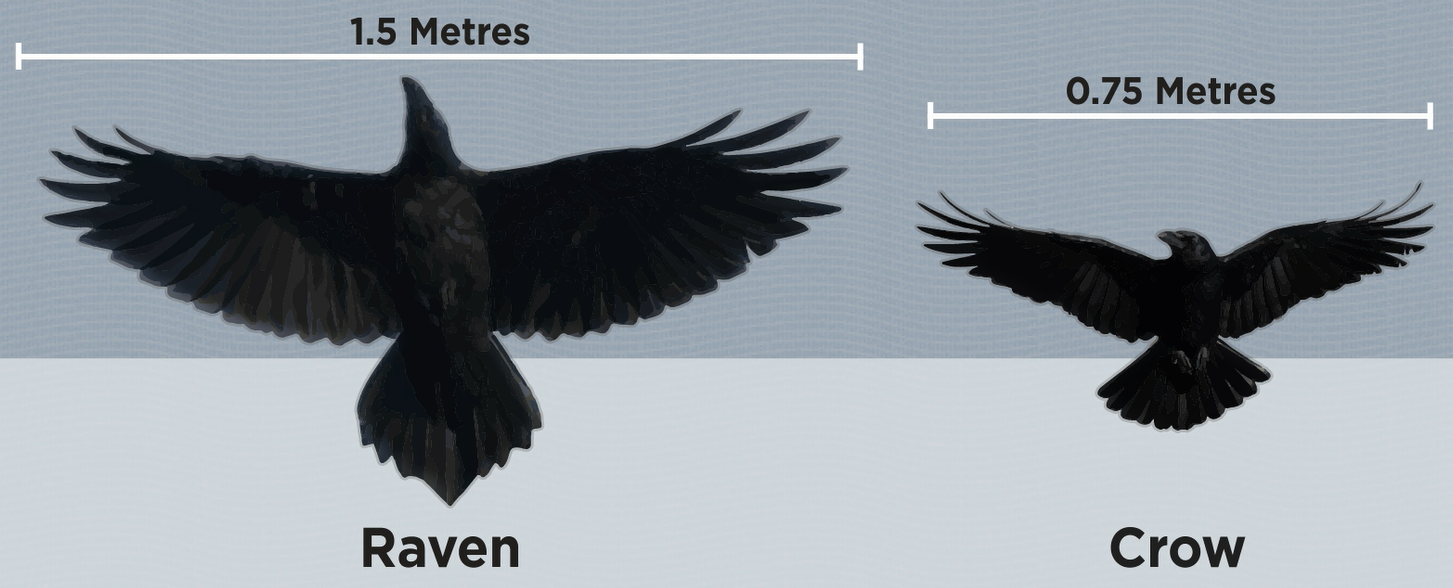
Common Raven vs American Crow -
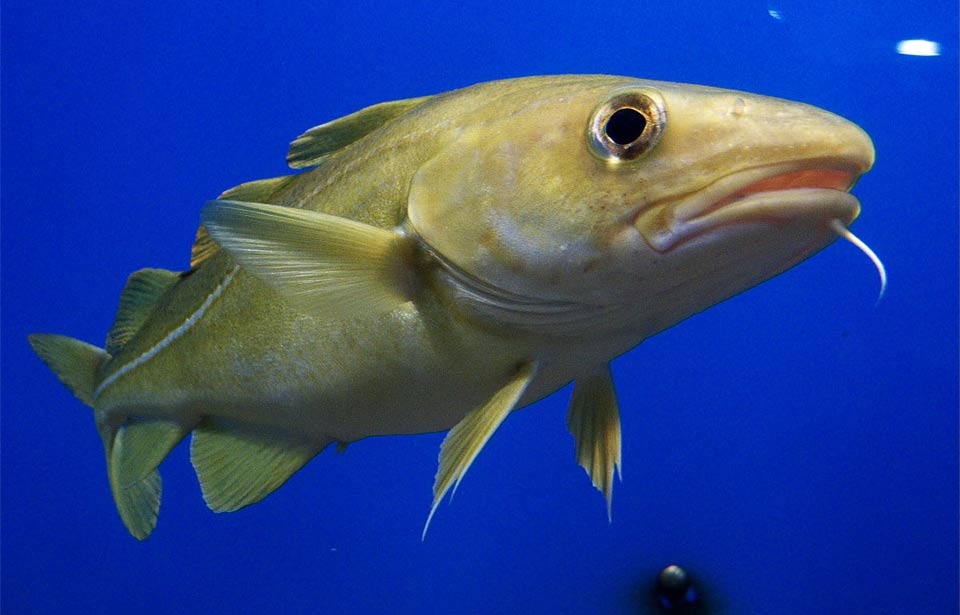 Atlantic Cod Atlantic Cod (Youth) Atlantic Cod (15 seconds) Atlantic Cod (30 seconds) Atlantic Cod
Atlantic Cod Atlantic Cod (Youth) Atlantic Cod (15 seconds) Atlantic Cod (30 seconds) Atlantic Cod 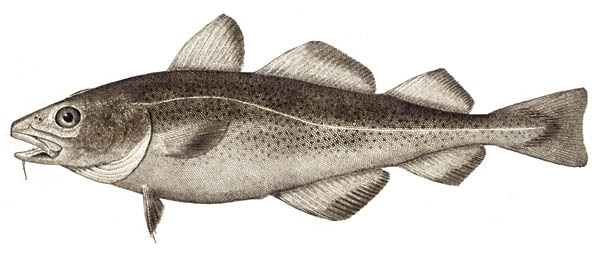 The Atlantic Cod (Gadus morhua) is a medium to large saltwater fish: generally averaging two to three kilograms in weight and about 65 to 100 centimetres in length, the largest cod on record weighed about 100 kg and was more than 180 cm long! Individuals living closer to shore tend to be smaller than their offshore relatives, but male and female cod are not different in size, wherever they live.
The Atlantic Cod (Gadus morhua) is a medium to large saltwater fish: generally averaging two to three kilograms in weight and about 65 to 100 centimetres in length, the largest cod on record weighed about 100 kg and was more than 180 cm long! Individuals living closer to shore tend to be smaller than their offshore relatives, but male and female cod are not different in size, wherever they live.The Atlantic Cod shares some of its physical features with the two other species of its genus, or group of species, named Gadus. The Pacific Cod and Alaska Pollock also have three rounded dorsal fins and two anal fins. They also have small pelvic fins right under their gills, and barbels (or whiskers) on their chins. Both Pacific and Atlantic Cod have a white line on each side of their bodies from the gills to their tails, or pectoral fins. This line is actually a sensory organ that helps fish detect vibrations in the water.
The colour of an Atlantic Cod is often darker on its top than on its belly, which is silver, white or cream-coloured. Its exact colour varies between individuals and seems to depend on its habitat in order to camouflage, or blend in: when there's lots of algae around, a cod can be reddish to greenish in colour, while a paler grey colour is more common closer to the sandy bottom of the ocean. In rocky areas, a cod may be a darker brown colour. Cod are often mottled, or have a lot of darker blotches or spots.
The Atlantic Cod may live as long as 25 years.
-
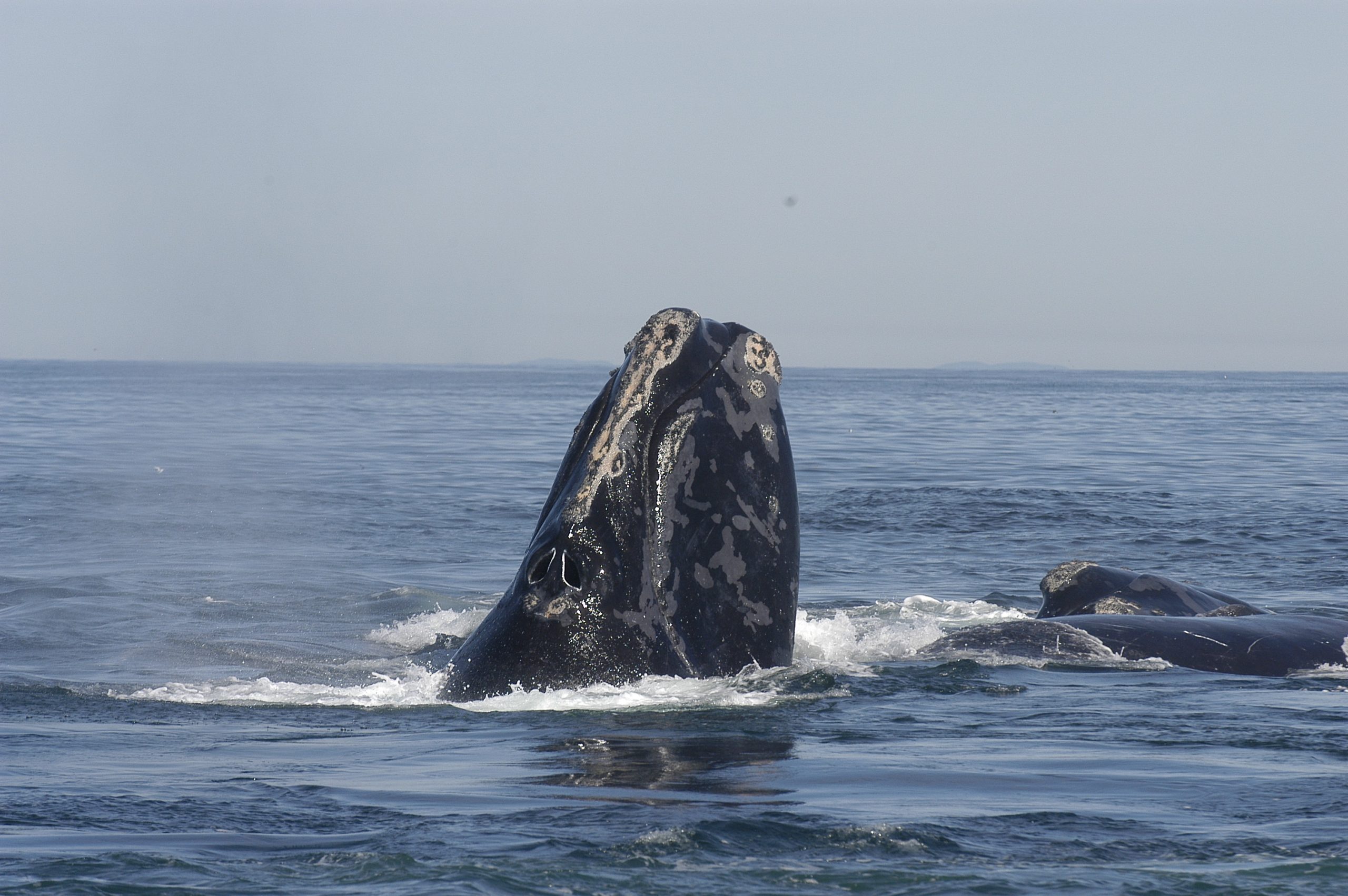 Moira Brown, New England Aquarium North Atlantic Right Whale North Atlantic Right Whale North Atlantic Right Whale (Youth) North Atlantic Right Whale (30 seconds) North Atlantic Right Whale (15 seconds)
Moira Brown, New England Aquarium North Atlantic Right Whale North Atlantic Right Whale North Atlantic Right Whale (Youth) North Atlantic Right Whale (30 seconds) North Atlantic Right Whale (15 seconds) 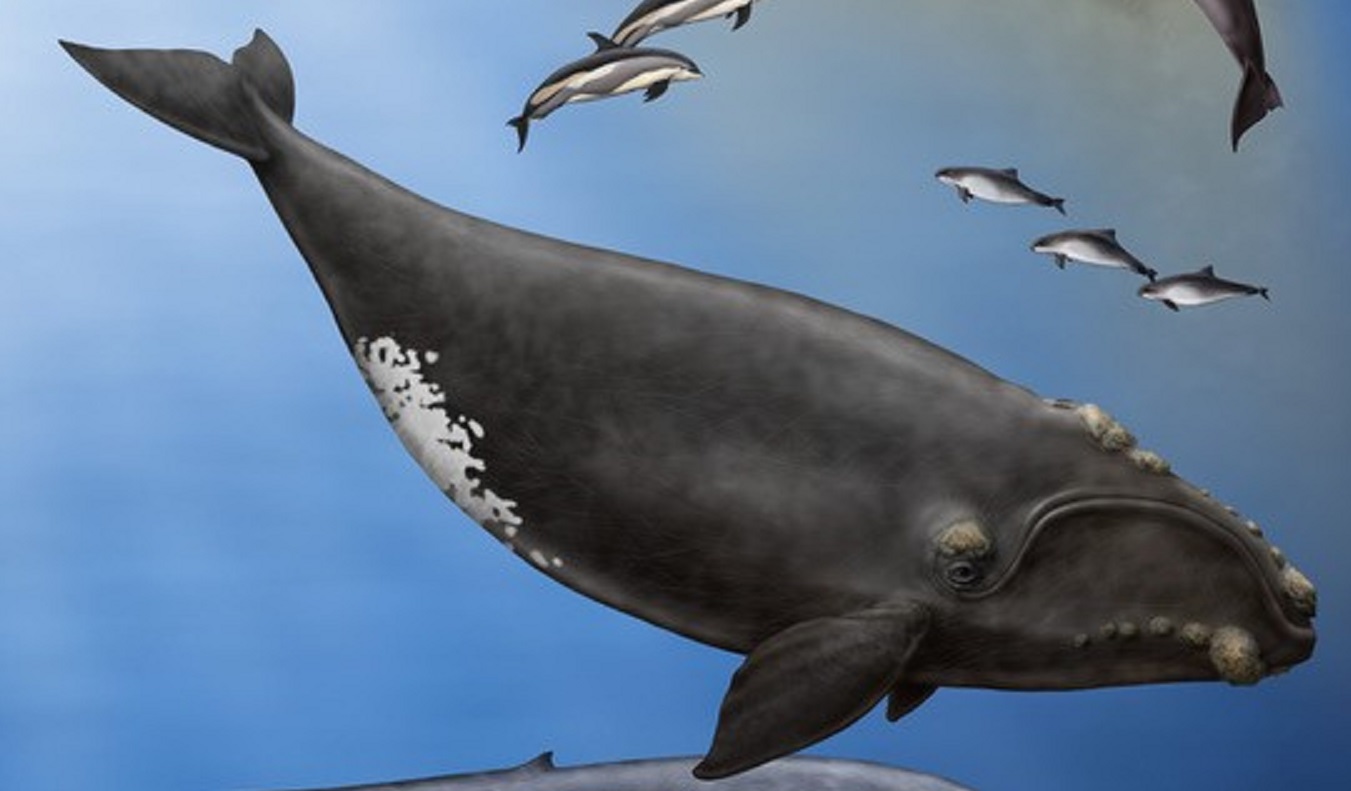 The North Atlantic Right Whale (Eubalæna glacialis) is one of the rarest of the large whales. It can weigh up to 63,500 kilograms and measure up to 16 metres. That's the length of a transport truck and twice the weight! Females tend to be a bit larger than males – measuring, on average, one metre longer. Considering its weight, it's fairly short, giving it a stocky, rotund appearance. Its head makes up about a fourth of its body length, and its mouth is characterized by its arched, or highly curved, jaw. The Right Whale's head is partially covered in what is called callosities (black or grey raised patches of roughened skin) on its upper and lower jaws, and around its eyes and blowhole. These callosities can appear white or cream as small cyamid crustaceans, called "whale lice", attach themselves to them. Its skin is otherwise smooth and black, but some individuals have white patches on their bellies and chin. Under the whale's skin, a blubber layer of sometimes more than 30 centimetres thick helps it to stay warm in the cold water and store energy. It has large, triangular flippers, or pectoral fins. Its tail, also called flukes or caudal fins, is broad (six m wide from tip to tip!), smooth and black. That's almost the same size as the Blue Whale's tail, even though Right Whales are just over half their size. Unlike most other large whales, it has no dorsal fin.
The North Atlantic Right Whale (Eubalæna glacialis) is one of the rarest of the large whales. It can weigh up to 63,500 kilograms and measure up to 16 metres. That's the length of a transport truck and twice the weight! Females tend to be a bit larger than males – measuring, on average, one metre longer. Considering its weight, it's fairly short, giving it a stocky, rotund appearance. Its head makes up about a fourth of its body length, and its mouth is characterized by its arched, or highly curved, jaw. The Right Whale's head is partially covered in what is called callosities (black or grey raised patches of roughened skin) on its upper and lower jaws, and around its eyes and blowhole. These callosities can appear white or cream as small cyamid crustaceans, called "whale lice", attach themselves to them. Its skin is otherwise smooth and black, but some individuals have white patches on their bellies and chin. Under the whale's skin, a blubber layer of sometimes more than 30 centimetres thick helps it to stay warm in the cold water and store energy. It has large, triangular flippers, or pectoral fins. Its tail, also called flukes or caudal fins, is broad (six m wide from tip to tip!), smooth and black. That's almost the same size as the Blue Whale's tail, even though Right Whales are just over half their size. Unlike most other large whales, it has no dorsal fin.For a variety of reasons, including its rarity, scientists know very little about this rather large animal. For example, there is little data on the longevity of Right Whales, but photo identification on living whales and the analysis of ear bones and eyes on dead individuals can be used to estimate age. It is believed that they live at least 70 years, maybe even over 100 years, since closely related species can live as long.
Unique characteristics
The Right Whale has a bit of an unusual name. It is thought to have been named by whalers as the "right" whale to hunt due to its convenient tendencies to swim close to shore and float when dead. Its name in French is more straightforward; baleine noire, the black whale.
-
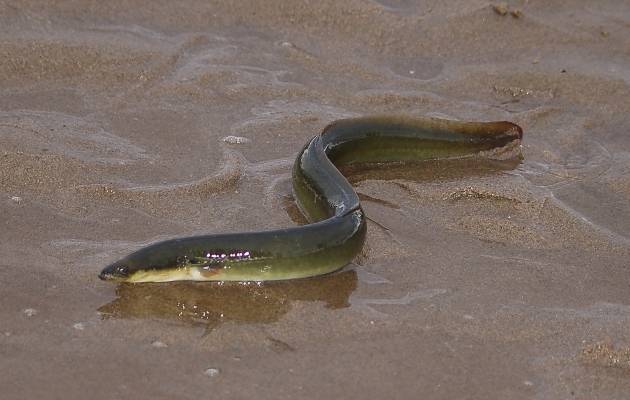 Parks Canada / Parcs Canada American Eel Ocean Commotion (webisode)
Parks Canada / Parcs Canada American Eel Ocean Commotion (webisode) The American Eel (Anguilla rostrata) is a fascinating migratory fish with a very complex life cycle. Like salmon, it lives both in freshwater and saltwater. But its life-cycle is exactly the reverse of salmon's: the eel is a catadromous species. It is born in saltwater and migrating to freshwater to grow and mature before returning to saltwater to spawn and die. The American Eel can live as long as 50 years.
It is a long, slender fish that can grow longer than one metre in length and 7.5 kilograms in weight. Males tend to be smaller than females, reaching a size of about 0.4 m. With its small pectoral fins right behind its gills, absence of pelvic fins, long dorsal and ventral fins and the thin coat of mucus on its tiny scales, the adult eel slightly resembles a slimy snake but are in fact true fish. Adult eels vary in coloration, from olive green and brown to greenish-yellow, with a light gray or white belly. Females are lighter in colour than males. Large females turn dark grey or silver when they mature.
It is known by a variety of names in Canada, including: the Atlantic Eel, the Common Eel, the Silver Eel, the Yellow Eel, the Bronze Eel and Easgann in Irish Gaelic. In Indigenous languages, like Mi'kmaq, it is known as k'at or g'at, the Algonquins call it pimzi or pimizi, in Ojibwe bimizi, in Cree Kinebikoinkosew and the Seneca call it goda:noh.
The American Eel is the only representative of its genus (or group of related species) in North America, but it does have a close relative which shares the same spawning area: the European Eel. Both have similar lifecycles but different distributions in freshwater systems except in Iceland, where both (and hybrids of both species) can be found. -
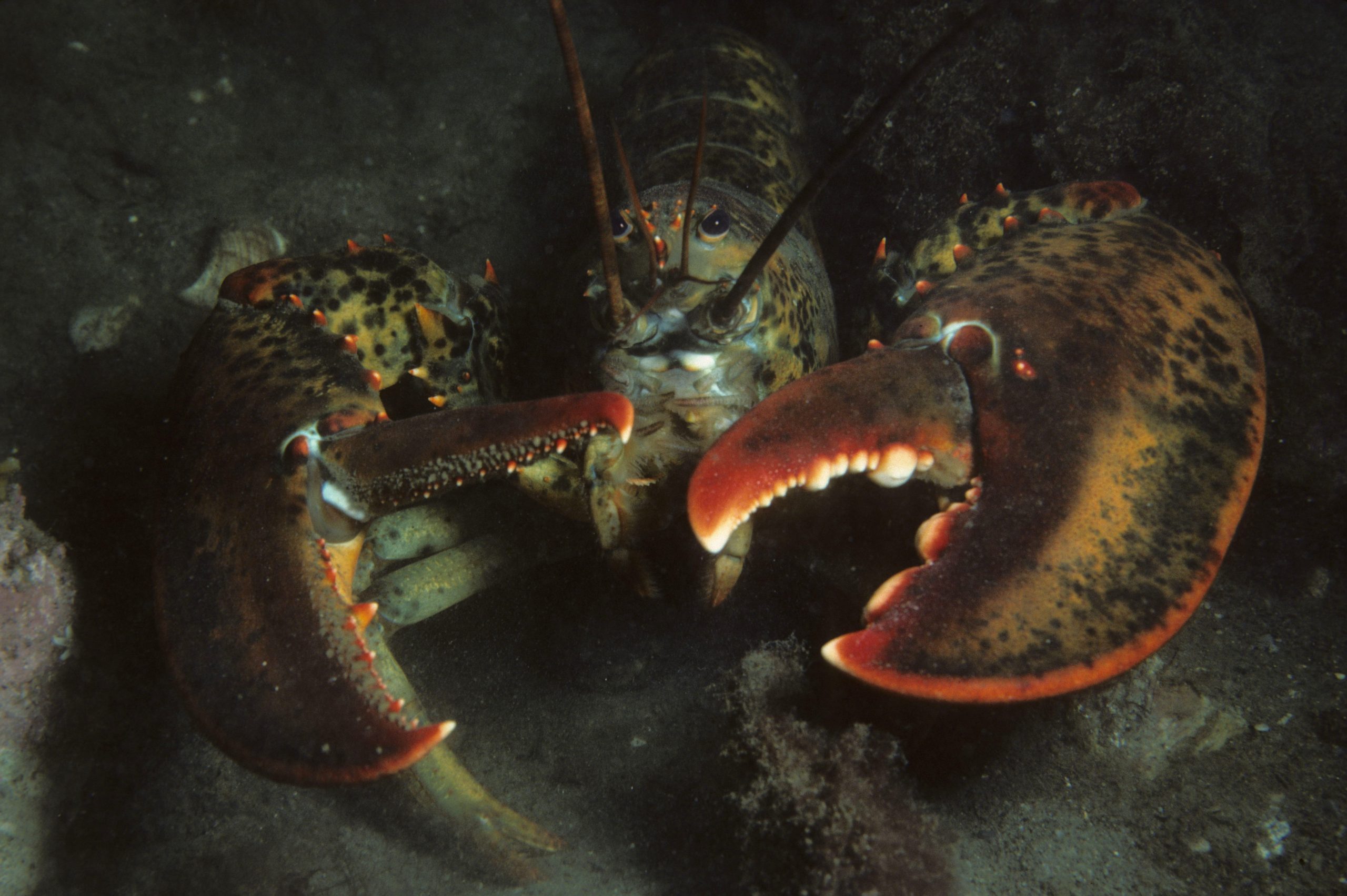 Thinkstock North American Lobster North American Lobster North American Lobster (30-seconds) North American Lobster (youth) North American Lobster (15-seconds)
Thinkstock North American Lobster North American Lobster North American Lobster (30-seconds) North American Lobster (youth) North American Lobster (15-seconds) 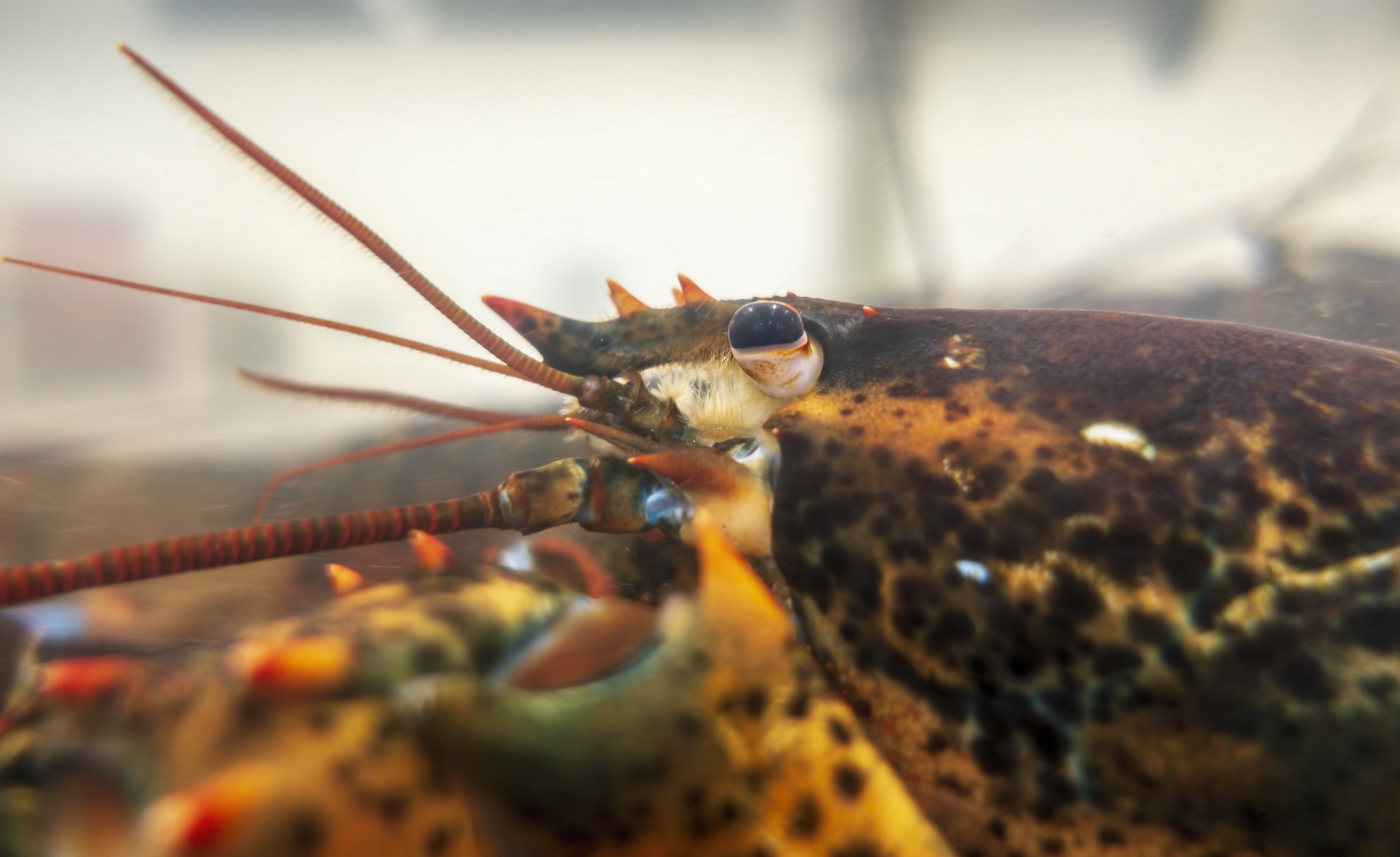
North American Lobster Head
The American Lobster (Homarus americanus) is a marine invertebrate which inhabits our Atlantic coastal waters. As an invertebrate, it lacks bones, but it does have an external shell, or exoskeleton, making it an arthropod like spiders and insects. Its body is divided in two parts: the cephalothorax (its head and body) and its abdomen, or tail. On its head, the lobster has eyes that are very sensitive to movement and light, which help it to spot predators and prey, but are unable to see colours and clear images. It also has three pairs of antennae, a large one and two smaller ones, which are its main sensory organs and act a bit like our nose and fingers. These antennae are able to smell the water to locate prey and touch elements in the lobster's environment so it can find its way. The lobster's mouth is located just below its eyes. Around its mouth are small appendages called maxillipeds and mandibles which help direct food to the mouth and chew. Food is then brought to the first of the lobster's two stomachs, which is just inside its mouth! The lobster's respiratory system is made of gills, like fish, which are situated on each side of its cephalothorax.
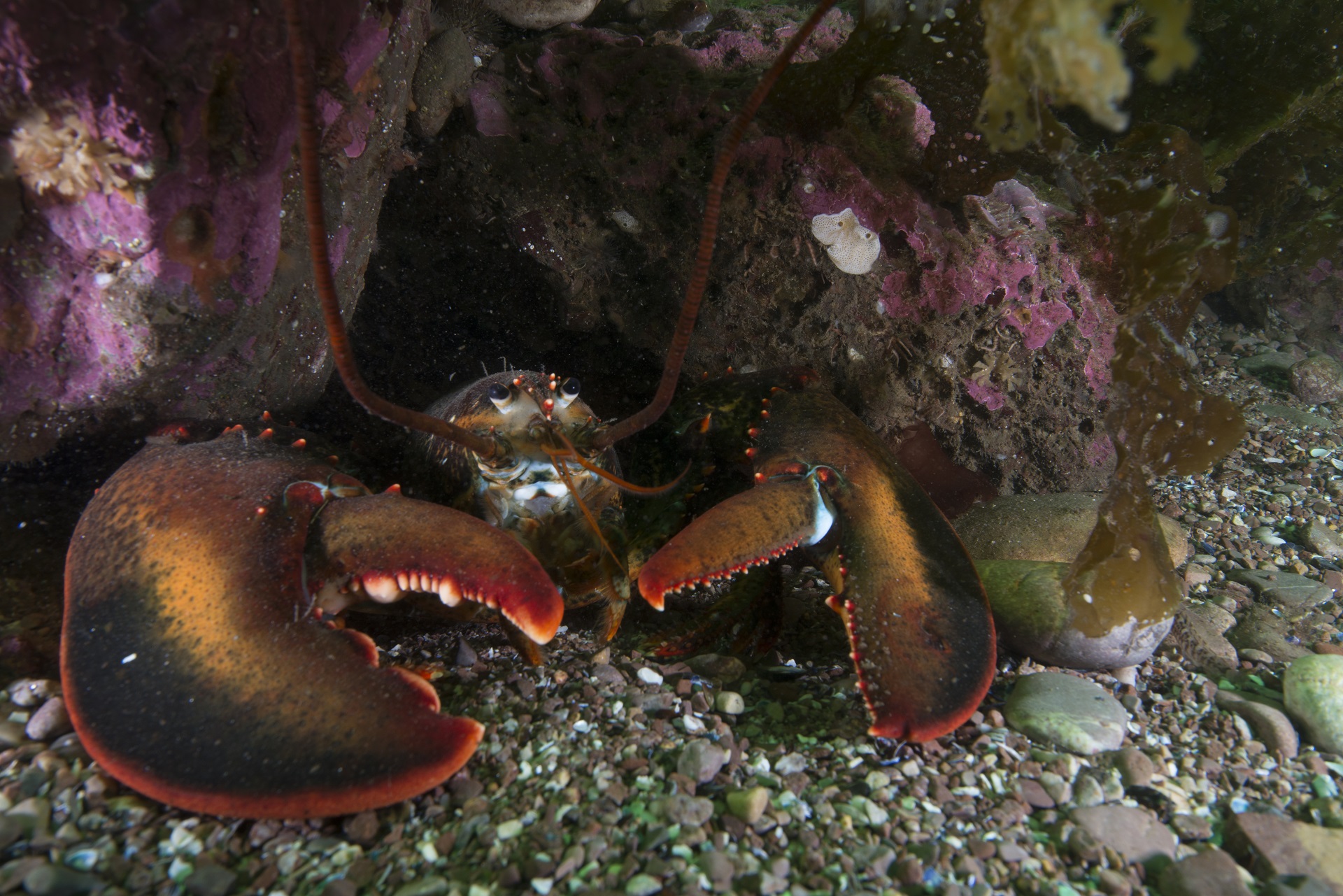
North American Lobster Showing Its Different claws
The lobster's legs are also found on the cephalothorax. Lobsters have ten legs, making them decapod (ten-legged) crustaceans, a group to which shrimp and crabs also belong (other arthropods have a different number of legs, like spiders, which have eight, and insects, which have six). Four pairs of these legs are used mainly to walk and are called pereiopods. The remaining pair, at the front of the cephalothorax, are called chelipeds and each of those limbs ends with a claw. These claws help the lobster defend itself, but also capture and consume its prey. Each claw serves a different purpose: the bigger, blunter one is used for crushing, and the smaller one with sharper edges, for cutting. The claw used for crushing can be on the lobster's right or left side, making it "right-handed" or "left-handed". When a lobster's limb, claw or antennae becomes damaged or lost, it is regrown when the lobster moults, a process called autotomy or regeneration. Hairs on the lobster's legs and claws also act as sensory organs and are able to smell.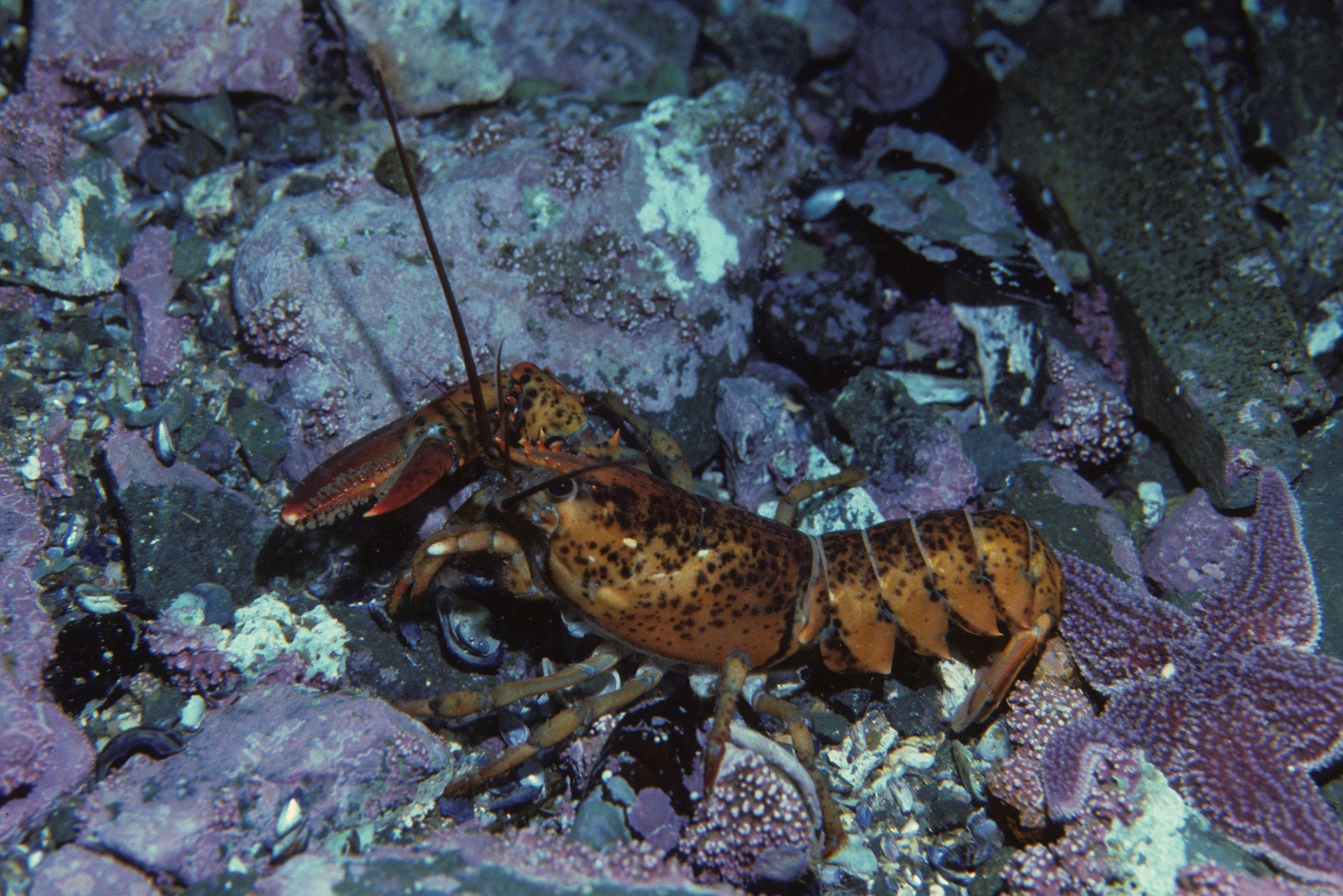
North American Lobster Missing A Claw
-
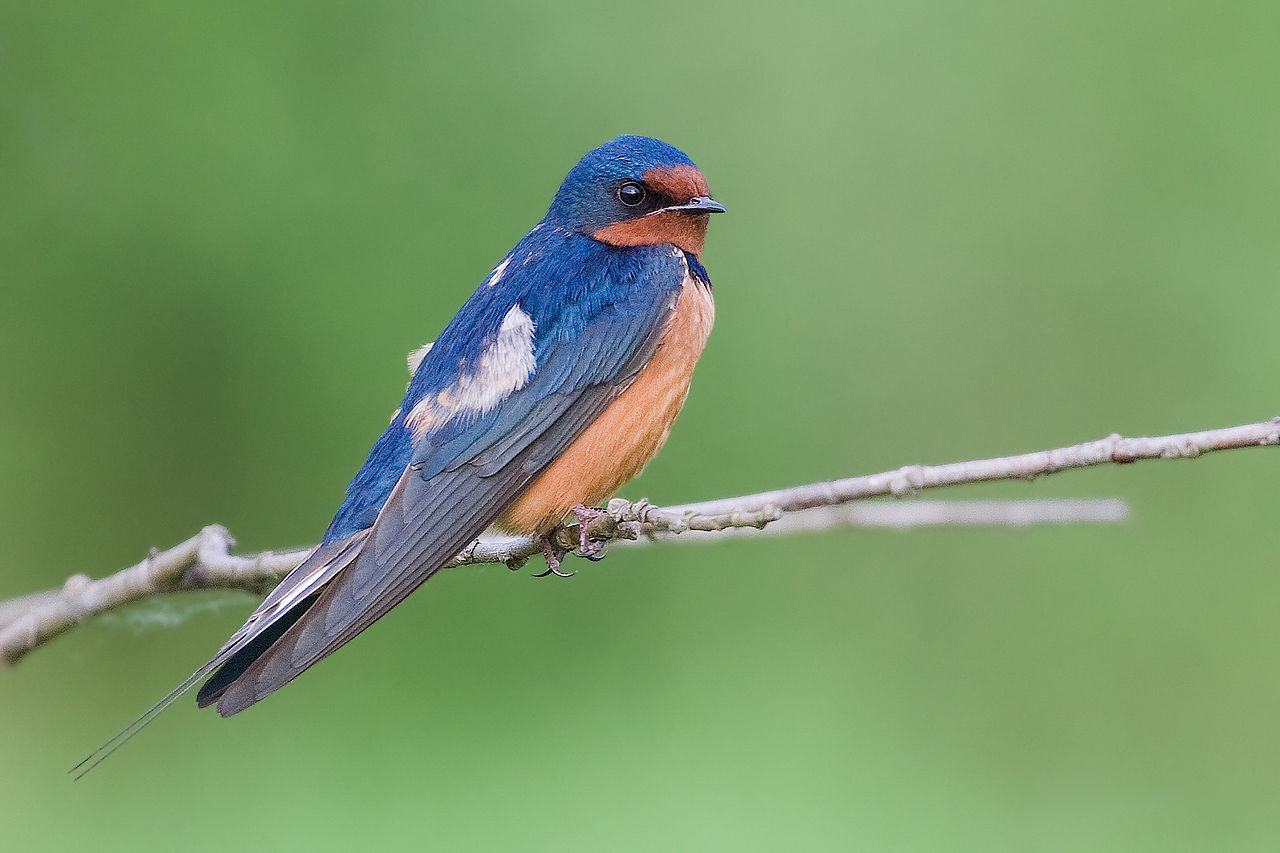 J.J. Cadiz Barn Swallow Barn Swallow (60 seconds) Barn Swallow (30 seconds)
J.J. Cadiz Barn Swallow Barn Swallow (60 seconds) Barn Swallow (30 seconds) 
Barn Swallow (photo by J.J. Cadiz)The Barn Swallow (Hirundo rustica) is a medium-sized songbird, about the size of a sparrow. It measures between 15 and 18 centimeters (cm) in length and 29 to 32 cm in wingspan, and weighs between 15 and 20 grams (g). But while it is average-sized, it's far from average-looking! Its back and tail plumage is a distinctive steely, iridescent blue, with light brown or rust belly and a chestnut-coloured throat and forehead. Their long forked tail and pointed wings also make them easily recognizable. It's these wings, tail and streamlined bodies that make their fast, acrobatic flight possible. Both sexes may look similar, but females are typically not as brightly coloured and have shorter tails than males. When perched, this swallow looks almost conical because of its flat, short head, very short neck and its long body.
Although the average lifespan of a Barn Swallow is about four years, a North American individual older than eight years and a European individual older than 16 years have been observed.
Sights and sounds:
Like all swallows, the Barn Swallow is diurnal –it is active during the day, from dusk to dawn. It is an agile flyer that creates very acrobatic patterns in flight. It can fly from very close to the ground or water to more than 30 m heights. The species may be the fastest swallow, as it's been recorded at speeds close to 75 kilometers per hour (km/h). When not in flight, the Barn Swallow can be observed perched on fences, wires, TV antennas or dead branches.Both male and female Barn Swallows sing both individually and in groups in a wide variety of twitters, warbles, whirrs and chirps. They give a loud call when threatened, to which other swallows will react, leaving their nests to defend the area.
-
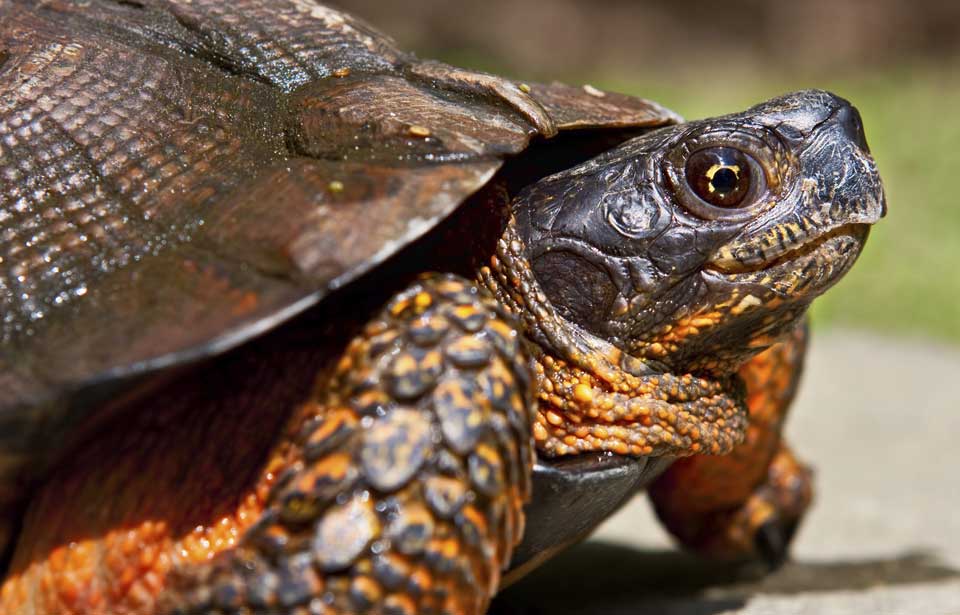 Thinkstock Freshwater Turtles Freshwater Turtles (30 seconds) Freshwater Turtles
Thinkstock Freshwater Turtles Freshwater Turtles (30 seconds) Freshwater Turtles 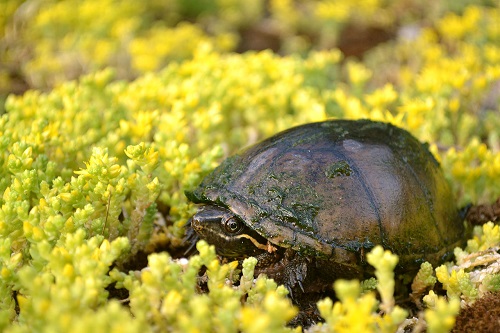
Stinkpot
Freshwater turtles are reptiles, like snakes, crocodilians and lizards. Like other reptiles, they are ectothermic, or "cold-blooded", meaning that their internal temperature matches that of their surroundings. They also have a scaly skin, enabling them, as opposed to most amphibians, to live outside of water. Also like many reptile species, turtles lay eggs (they are oviparous). But what makes them different to other reptiles is that turtles have a shell. This shell, composed of a carapace in the back and a plastron on the belly, is made of bony plates. These bones are covered by horny scutes made of keratin (like human fingernails) or leathery skin, depending on the species. All Canadian freshwater turtles can retreat in their shells and hide their entire body except the Common Snapping Turtle (Chelydra serpentina). This shell is considered perhaps the most efficient form of armour in the animal kingdom, as adult turtles are very likely to survive from one year to the next. Indeed, turtles have an impressively long life for such small animals. For example, the Blanding's Turtle (Emydoidea blandingi) can live for more than 70 years! Most other species can live for more than 20 years.
There are about 320 species of turtles throughout the world, inhabiting a great variety of terrestrial, freshwater and marine ecosystems on every continent except Antarctica and its waters. In Canada, eight native species of freshwater turtles (and four species of marine turtles) can be observed. Another species, the Pacific Pond Turtle (Clemmys marmorata), is now Extirpated, having disappeared from its Canadian range. Also, the Eastern Box Turtle (Terrapene carolina) has either such a small population that it is nearly Extirpated, or the few individuals found in Canada are actually pets released in the wild. More research is needed to know if these turtles are still native individuals. Finally, the Red-eared Slider (Trachemys scripta elegans), has been introduced to Canada as released pets and, thus, is not a native species.
-
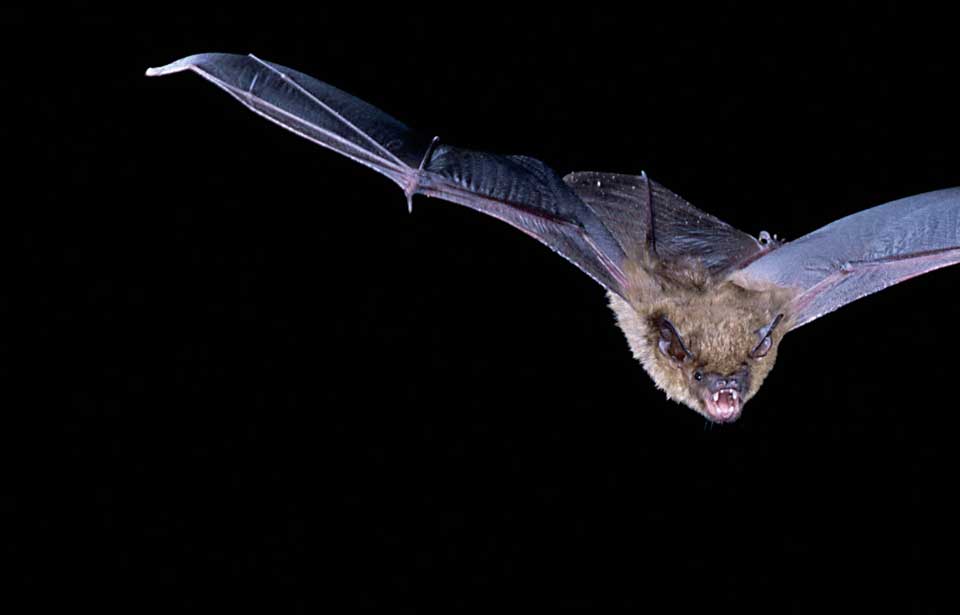 Thinkstock Little Brown Bat Little Brown Bat (30 seconds) Little Brown Bat (60 seconds)
Thinkstock Little Brown Bat Little Brown Bat (30 seconds) Little Brown Bat (60 seconds) 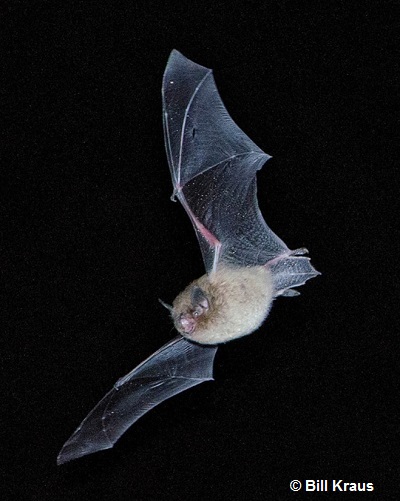
Little Brown Bat
The Little Brown Bat, or Little Brown Myotis (Myotis lucifugus) weighs between 7 and 9 g, and has a wingspan of between 25 and 27 cm. Females tend to be slightly larger than males but are otherwise identical. As its name implies, it is pale tan to reddish or dark brown with a slightly paler belly, and ears and wings that are dark brown to black.
Contrary to popular belief, Little Brown Bats, like all other bats, are not blind. Still, since they are nocturnal and must navigate in the darkness, they are one of the few terrestrial mammals that use echolocation to gather information on their surroundings and where prey are situated. The echolocation calls they make, similar to clicking noises, bounce off objects and this echo is processed by the bat to get the information they need. These noises are at a very high frequency, and so cannot be heard by humans.
-
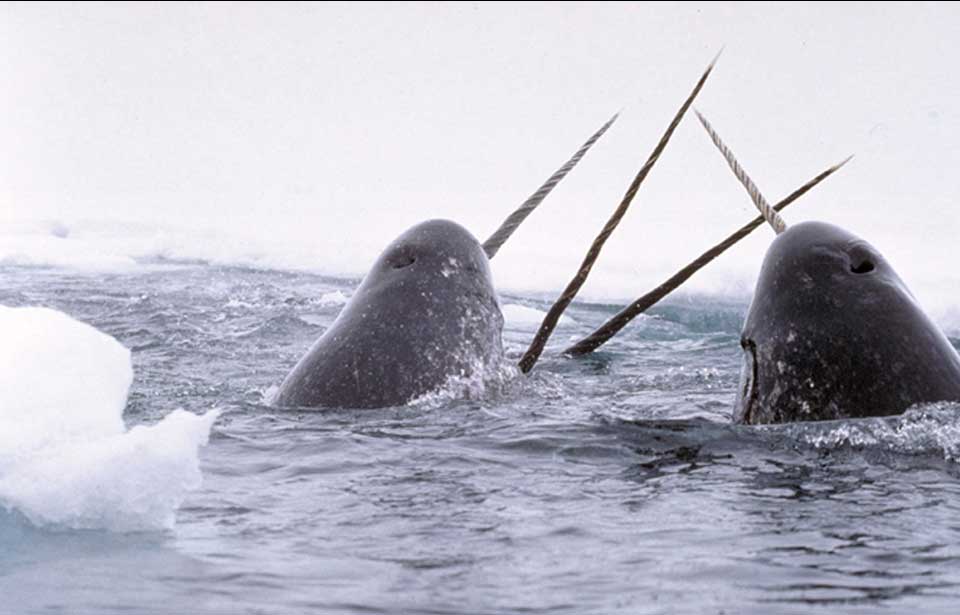 Glenn Williams Narwhal Narwhal (30 seconds) Narwhal (60 seconds)
Glenn Williams Narwhal Narwhal (30 seconds) Narwhal (60 seconds) Narwhals (Monodon monoceros) are considered medium-sized odontocetes, or toothed whales (the largest being the sperm whale, and the smallest, the harbour porpoise), being of a similar size to the beluga, its close relative. Males can grow up to 6.2 m -the average size being 4.7 m- and weigh about 1,600 kg. Females tend to be smaller, with an average size of 4 m and a maximum size of 5.1 m and weigh around 900 kg. A newborn calf is about 1.6 m long and weighs about 80 kilograms. The narwhal has a deep layer of fat, or blubber, about 10 cm thick, which forms about one-third of the animal's weight and acts as insulation in the cold Arctic waters.
Like belugas, they have a small head, a stocky body and short, round flippers. Narwhals lack a dorsal fin on their backs, but they do have a dorsal ridge about 5 cm high that covers about half their backs. This ridge can be used by researchers to differentiate one narwhal from another. It is thought that the absence of dorsal fin actually helps the narwhal navigate among sea ice. Unlike other cetaceans –the order which comprises all whales–, narwhals have convex tail flukes, or tail fins.
These whales have a mottled black and white, grey or brownish back, but the rest of the body (mainly its underside) is white. Newborn narwhal calves are pale grey to light brownish, developing the adult darker colouring at about 4 years old. As they grow older, they will progressively become paler again. The narwhal's colouring gives researchers an idea about how old an individual is. Some may live up to 100 years, but most probably live to be 60 years of age.
The narwhal's most striking feature is undoubtedly its tusk. This long, spiral upper incisor tooth (one of the two teeth narwhals have) grows out from the animal's upper jaw, and can measure up to 3 m and weigh up to 10 kg. Although the second, smaller incisor tooth often remains embedded in the skull, it rarely but on occasion develops into a second tusk. Tusks typically grow only on males, but a few females have also been observed with short tusks. The function of the tusk remains a mystery, but several hypotheses have been proposed. Many experts believe that it is a secondary sexual character, similar to deer antlers. Thus, the length of the tusk may indicate social rank through dominance hierarchies and assist in competition for access to females. Indeed, there are indications that the tusks are used by male narwhals for fighting each other or perhaps other species, like the beluga or killer whale. A high quantity of tubules and nerve endings in the pulp –the soft tissue inside teeth – of the tusk have at least one scientist thinking that it could be a highly sensitive sensory organ, able to detect subtle changes in temperature, salinity or pressure. Narwhals have not been observed using their tusk to break sea ice, despite popular belief. Narwhals do occasionally break the tip of their tusk though which can never be repaired. This is more often seen in old animals and gives more evidence that the tusk might be used for sexual competition. The tusk grows all throughout a male's lifespan but slows down with age.
-
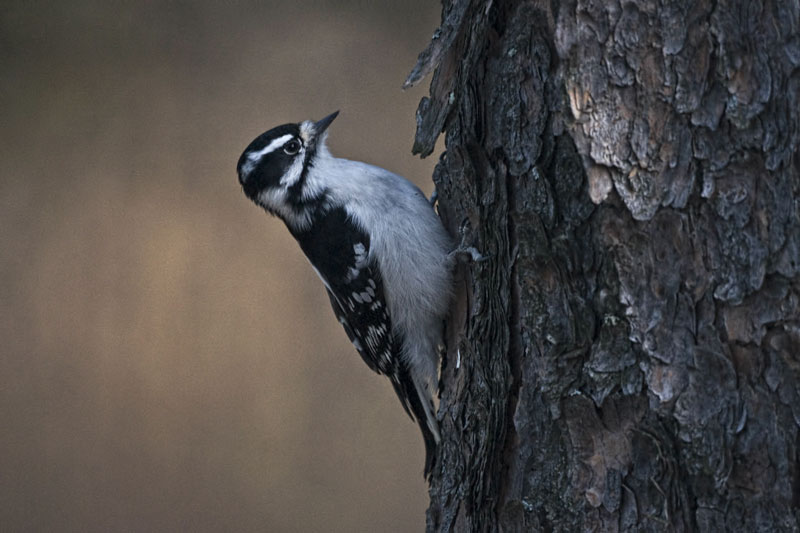 Laurenz Baars Downy Woodpecker
Laurenz Baars Downy Woodpecker Of the 198 species of woodpeckers worldwide, 13 are found in Canada. The smallest and perhaps most familiar species in Canada is the Downy Woodpecker Picoides pubescens. It is also the most common woodpecker in eastern North America.
This woodpecker is black and white with a broad white stripe down the back from the shoulders to the rump. Its wings are checkered in a black and white pattern that shows through on the wings' undersides, and the breast and flanks are white. The crown of the head is black; the cheeks and neck are adorned with black and white lines. Male and female Downy Woodpeckers are about the same size, weighing from 21 to 28 g. The male has a small scarlet patch, like a red pompom, at the back of the crown.
The Downy Woodpecker looks much like the larger Hairy Woodpecker Picoides villosus, but there are some differences between them. The Downy's outer tail feathers are barred with black, unlike the Hairy Woodpecker's, which are all white. The Downy is about 6 cm smaller than the Hairy, measuring only 15 to 18 cm from the tip of its bill to the tip of its tail. And the Downy's bill is shorter than its head, whereas the Hairy's bill is as long as or longer than its head length. The Downy's name refers to the soft white feathers of the white strip on the lower back, which differ from the more hairlike feathers on the Hairy Woodpecker.
Woodpeckers are a family of birds sharing several characteristics that separate them from other avian families. Most of the special features of their anatomy are associated with the ability to dig holes in wood. The straight, chisel-shaped bill is formed of strong bone overlaid with a hard covering and is quite broad at the nostrils in order to spread the force of pecking. A covering of feathers over the nostrils keeps out pieces of wood and wood powder. The pelvic bones are wide, allowing for attachment of muscles strong enough to move and hold the tail, which is important for climbing.
Another special anatomical trait of woodpeckers is the long, barbed tongue that searches crevices and cracks for food. The salivary glands produce a sticky, glue-like substance that coats the tongue and, along with the barbs, makes the tongue an efficient device for capturing insects.
Signs and sounds
As early as February or March a Downy Woodpecker pair indicate that they are occupying their nesting site by flying around it and by drumming short, fast tattoos with their bills on dry twigs or other resonant objects scattered about the territory. The drumming serves as a means of communication between the members of the pair as well. Downys also have a variety of calls. They utter a tick, tchick, tcherrick, and both the male and the female add a sharp whinnying call during the nesting season.
Hatchlings give a low, rhythmic pip note, which seems to indicate contentment. When a parent enters the nest cavity, the nestlings utter a rasping begging call, which becomes stronger and longer as the chicks mature.
-
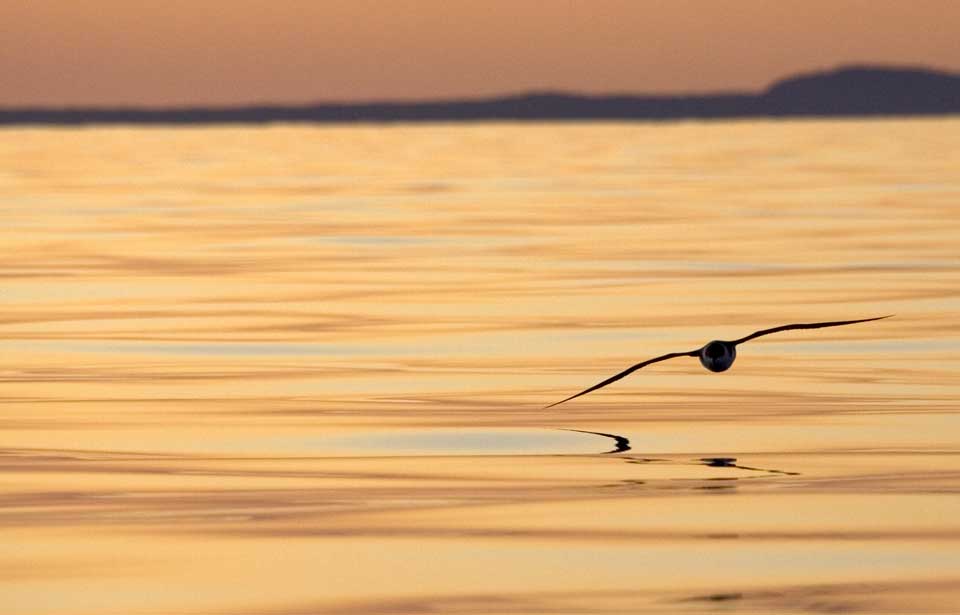 Seabirds Ocean Commotion (webisode)
Seabirds Ocean Commotion (webisode) 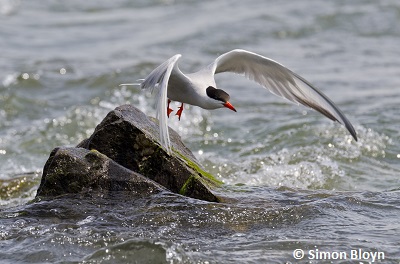
Common Tern
Everyone who has visited the coast is familiar with gulls, those graceful, long-winged birds that throng the beaches and harbours and boldly beg for scraps. The gulls are a family of birds that live mainly at sea, either along the shore, or out in the ocean itself. Worldwide, there are more than 350 species of birds that live either partially or exclusively at sea, and these are generally known as "seabirds."
The table below lists the 14 families of marine birds and the approximate number of species in each (the exact number of species is continually being revised as genetic research reveals that some very similar-looking birds are so different in their genetic makeup that they constitute different species). All species belonging to the albatross, auk, frigatebird, gannet, penguin, petrel, and storm-petrel families feed exclusively at sea. In addition, many species of cormorants, grebes, gulls, jaegers, loons, pelicans and terns feed either entirely or mainly at sea. The Phalaropes are the only shorebirds that feed at sea.
Families of birds in which all species feed either entirely of partially at sea and the approximate number of species in each family appear below (from https://www.worldbirdnames.org/ioc-lists/master-list/). The number of species that breed in Canada are shown in parentheses. Ducks and grebes that feed at sea are not included.
-
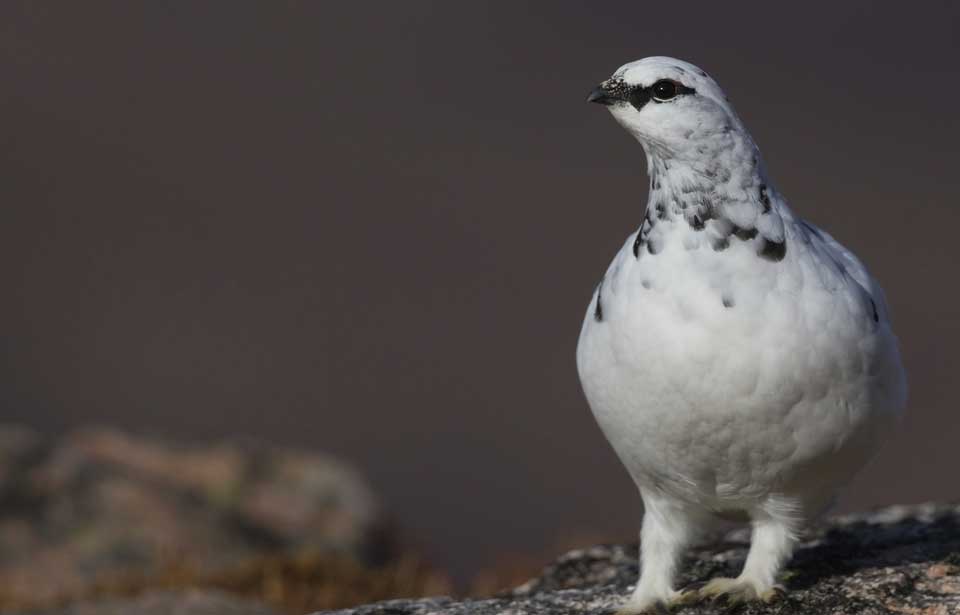 Thinkstock Ptarmigan Ptarmigan
Thinkstock Ptarmigan Ptarmigan  Ptarmigans are hardy members of the grouse family that spend most of their lives on the ground at or above the treeline. Three species are present in North America: the Willow Ptarmigan Lagopus lagopus, the White-tailed Ptarmigan Lagopus leucurus, and the Rock Ptarmigan Lagopus mutus.Like other grouse, ptarmigans have chunky bodies, short tails and legs, and short, rounded wings. Willow Ptarmigans weigh from 450 to 800 g, White-tailed Ptarmigans weigh about 350 g, and Rock Ptarmigans are intermediate in size.
Ptarmigans are hardy members of the grouse family that spend most of their lives on the ground at or above the treeline. Three species are present in North America: the Willow Ptarmigan Lagopus lagopus, the White-tailed Ptarmigan Lagopus leucurus, and the Rock Ptarmigan Lagopus mutus.Like other grouse, ptarmigans have chunky bodies, short tails and legs, and short, rounded wings. Willow Ptarmigans weigh from 450 to 800 g, White-tailed Ptarmigans weigh about 350 g, and Rock Ptarmigans are intermediate in size. All ptarmigans have feathered feet, unique among chickenlike birds, which improve their ability to walk in snow. They also have white wings throughout the year. Inflatable red combs above their eyes, which are especially evident in territorial and courting males, are inconspicuous to barely visible in females.
Ptarmigans have three seasonal plumages per year, instead of the two that are usual for most birds. These plumages keep the birds, particularly the female, well camouflaged at all times. In winter, all ptarmigans of both sexes are basically white. Whereas White-tailed Ptarmigans have permanently white tail feathers, the tails of Willow and Rock Ptarmigans remain black throughout the year. In winter, male—and some female—Rock Ptarmigans sport a black stripe that extends through the eye to the bill (as if they had put on charcoal goggles to prevent snow blindness), distinguishing them from male Willow Ptarmigans.
In ptarmigans, the moult, or shedding of old feathers, starts with the head and progresses towards the tail. As soon as the spring snowmelt begins, females moult into a barred breeding plumage of brown, gold, and black. Female ptarmigans are difficult to tell apart in spring, but the overall tones of the White-tailed Ptarmigan females are cooler in comparison to those of the other two species. Breeding males delay their moult.
Source: https://www.hww.ca/en/issues-and-topics/bird-feeding.html
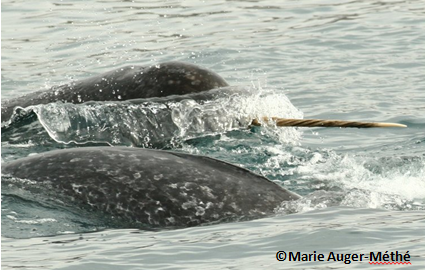
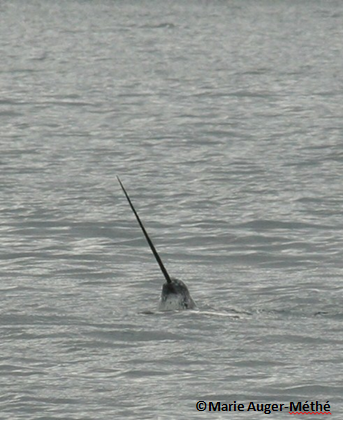
0 Response to "Bird Feeding and Girl Gagging Videos"
Post a Comment